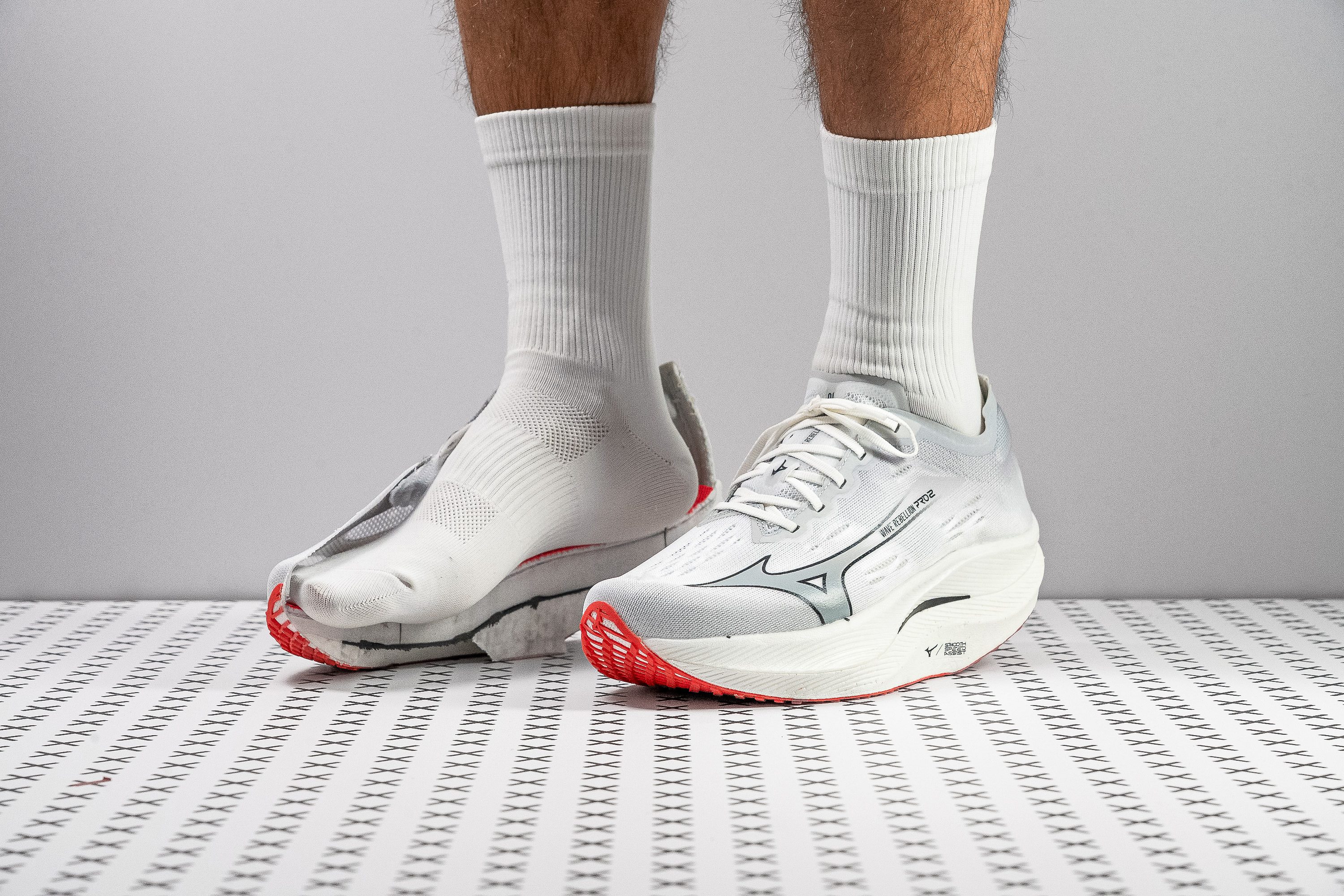Our verdict
- Top pick in best Running shoes for knee pain
Pros
- Truly unique
- Significant improvements from v1
- Complies with World Athletics regulations
- Ideal for midfoot strikers
- Enhances forward momentum
- Dependable traction
- Reduced weight
- Ultra-fun running experience
Cons
- Energy return is low compared to other supershoes
- Stability issues
- Not suited for rearfoot or forefoot strikers
Audience verdict
- Top 19% in road running shoes
- Top 18% in neutral running shoes
Comparison
The most similar running shoes compared
+ + Add a shoe | |||||
|---|---|---|---|---|---|
| Audience score | 90 Great! | 90 Great! | 90 Great! | 86 Good! | |
| Price | £210 | £195 | £260 | £210 | |
| Pace | Competition | CompetitionTempo | Competition | Competition | |
| Shock absorption | High | High | High | High | |
| Energy return | Moderate | High | High | High | |
| Traction | High | High | High | High | |
| Arch support | Neutral | Neutral | Neutral | Neutral | |
| Weight lab Weight brand | 7.4 oz / 209g 7.6 oz / 215g | 7.2 oz / 204g 7.4 oz / 209g | 6.5 oz / 183g 6.4 oz / 181g | 8 oz / 227g 7.7 oz / 218g | |
| Lightweight | ✓ | ✓ | ✓ | ✓ | |
| Drop lab Drop brand | 2.1 mm 2.5 mm | 10.6 mm 8.0 mm | 6.5 mm 5.0 mm | 5.4 mm 4.0 mm | |
| Strike pattern | Mid/forefoot | Heel | Mid/forefoot | Mid/forefoot | |
| Size | True to size | True to size | Slightly small | - | |
| Midsole softness | Soft | Soft | Balanced | Soft | |
| Difference in midsole softness in cold | Small | Normal | Small | Small | |
| Toebox durability | Bad | Bad | Good | Good | |
| Heel padding durability | Good | Good | Good | Bad | |
| Outsole durability | Bad | Decent | Good | Decent | |
| Breathability | Moderate | Moderate | Breathable | Moderate | |
| Width / fit | Narrow | Medium | Narrow | Medium | |
| Toebox width | Medium | Narrow | Medium | Medium | |
| Stiffness | Stiff | Stiff | Stiff | Stiff | |
| Torsional rigidity | Stiff | Stiff | Stiff | Stiff | |
| Heel counter stiffness | Flexible | Flexible | Flexible | Flexible | |
| Plate | Carbon plate | Carbon plate | Carbon plate | Carbon plate | |
| Rocker | ✓ | ✓ | ✓ | ✓ | |
| Heel lab Heel brand | 37.9 mm 38.0 mm | 39.2 mm 40.0 mm | 39.1 mm 39.5 mm | 39.9 mm 39.5 mm | |
| Forefoot lab Forefoot brand | 35.8 mm 36.5 mm | 28.6 mm 32.0 mm | 32.6 mm 34.5 mm | 34.5 mm 35.5 mm | |
| Widths available | Normal | Normal | NormalWide | NormalWide | |
| Orthotic friendly | ✓ | ✓ | ✓ | ✓ | |
| Season | All seasons | All seasons | SummerAll seasons | All seasons | |
| Removable insole | ✓ | ✓ | ✓ | ✓ | |
| Ranking | #111 Top 17% | #43 Top 12% | #82 Top 22% | #191 Bottom 49% | |
| Popularity | #409 Bottom 38% | #49 Top 13% | #121 Top 33% | #172 Top 46% |
Who should buy
We highly recommend the Mizuno Wave Rebellion Pro 2 for:
- Runners seeking a great super shoe with a unique look.
- Midfoot strikers looking for a World Athletics legal shoe designed specifically for their stride.
- Neutral-gait marathoners fans of Mizuno that are in search of the brand's ultimate super shoe.
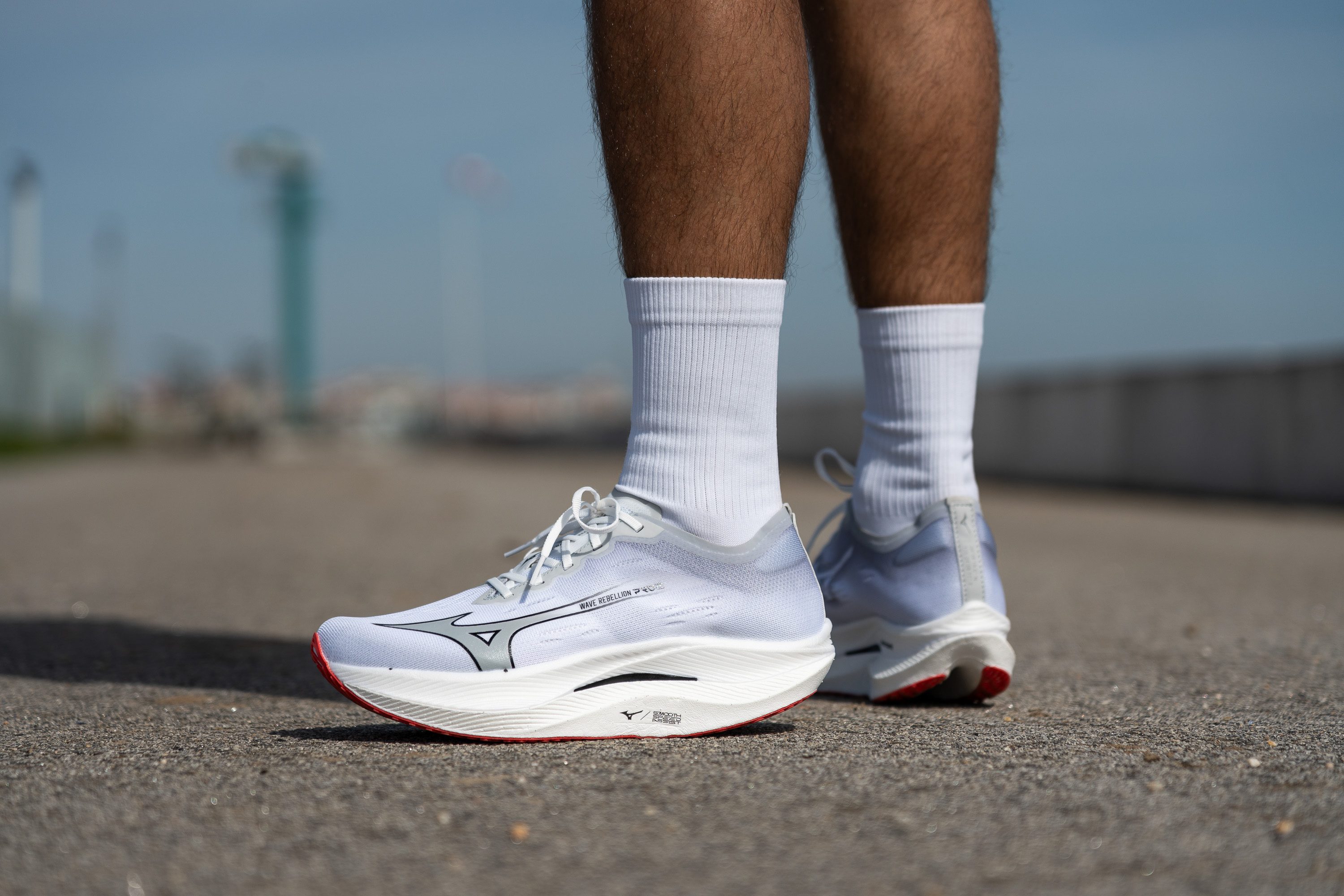
Who should NOT buy
In our extensive testing of the Mizuno Wave Rebellion Pro 2, we've determined it might not be the best fit for everyone, particularly for those prioritising energy return and stability. For those, we find that the Saucony Endorphin Elite and the Nike Alphafly 3 stand out as superior choices, offering more bang for your buck in this crucial aspect.
Additionally, we've observed that the Wave Rebellion Pro 2 may not provide the stable underfoot feel some runners seek in a high-performance super shoe. For those desiring a more secure and stable ride, we believe the Hoka Rocket X 2 and the Adidas Adizero Adios Pro 3 present themselves as more favourable options within a similar price bracket.
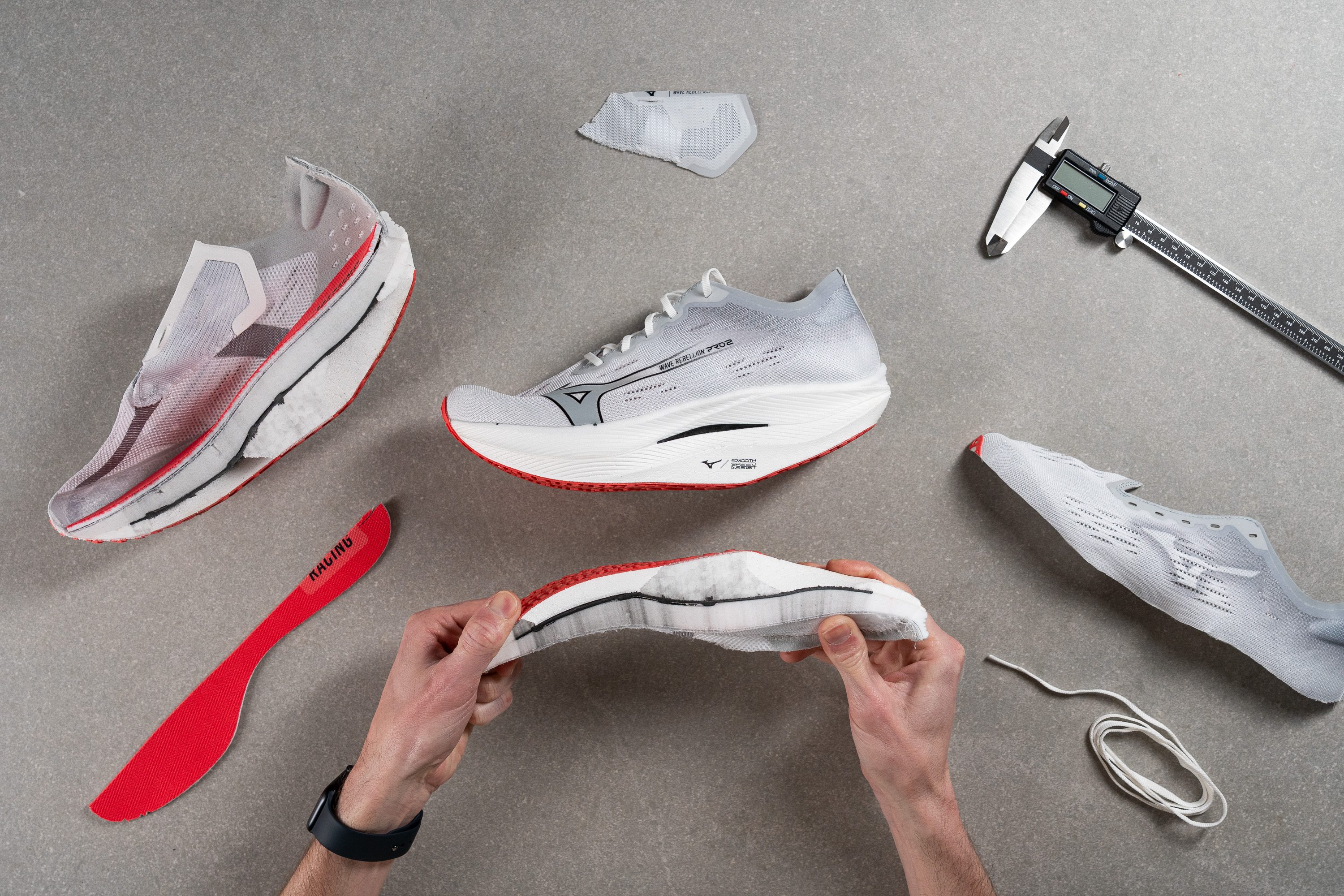
Cushioning
Shock absorption
The Wave Rebellion Pro 2 is a dream ride for midfoot strikers craving max shock absorption. We measured a jaw-dropping 159 SA in the heel! However, the forefoot reached just 116 SA due to the wild-looking midsole geometry limiting foam volume, though it’s still above average.

| Wave Rebellion Pro 2 | 159 SA |
| Average | 129 SA |
Energy return
On paper, this shoe looks like a super shoe. But when we tested it in our lab, the absence of a fully superfoam-based midsole became obvious. It delivered just 62.5% energy return, more in line with a responsive daily trainer like the Hoka Mach 6 than a true race-day beast.
| Wave Rebellion Pro 2 | 62.5% |
| Average | 58.5% |
Heel stack
The brilliance of the Mizuno Wave Rebellion Pro 2 shines through its innovative design. It masterfully adheres to World Athletics' 40 mm stack height limit at the heel, where we measured a precise 37.9 mm, thanks to its massive heel bevel.
While the shoe boasts way north than 40-mm in the midfoot, Mizuno has ingeniously ensured compliance with regulations, reminiscent of how Formula 1 teams navigate FIA rules. It's a strategic move by Mizuno that we love!
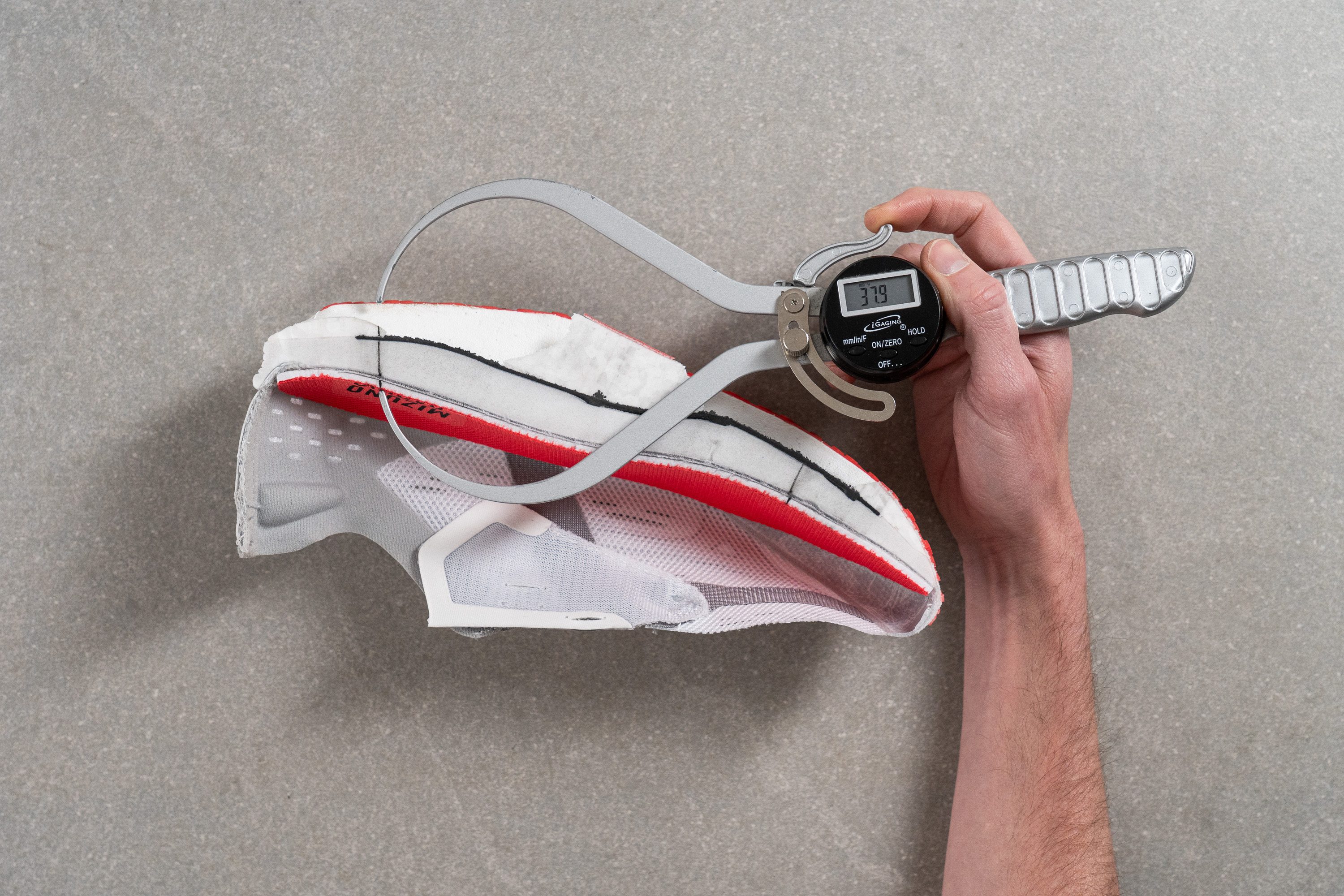
| Wave Rebellion Pro 2 | 37.9 mm |
| Average | 34.8 mm |
Forefoot stack
The forefoot's stack height reached an impressive 35.8 mm, setting a new record in the lab for the most substantial forefoot measurement in a World Athletics-compliant shoe.
This exceptional design promises unmatched cushioning, offering midfoot and forefoot strikers great support during marathons and long runs.

| Wave Rebellion Pro 2 | 35.8 mm |
| Average | 26.2 mm |
Drop
Mizuno claims the Wave Rebellion Pro 2 features a 2.5 mm drop, and our measurements showed a strikingly similar 2.1 mm, nearly matching the official specs.
Yet, the unique geometry of this shoe means the drop feels variable, depending on how you land. Forefoot strikers might perceive it as having a 6-mm offset, while midfoot and heel strikers could experience it as slightly less.
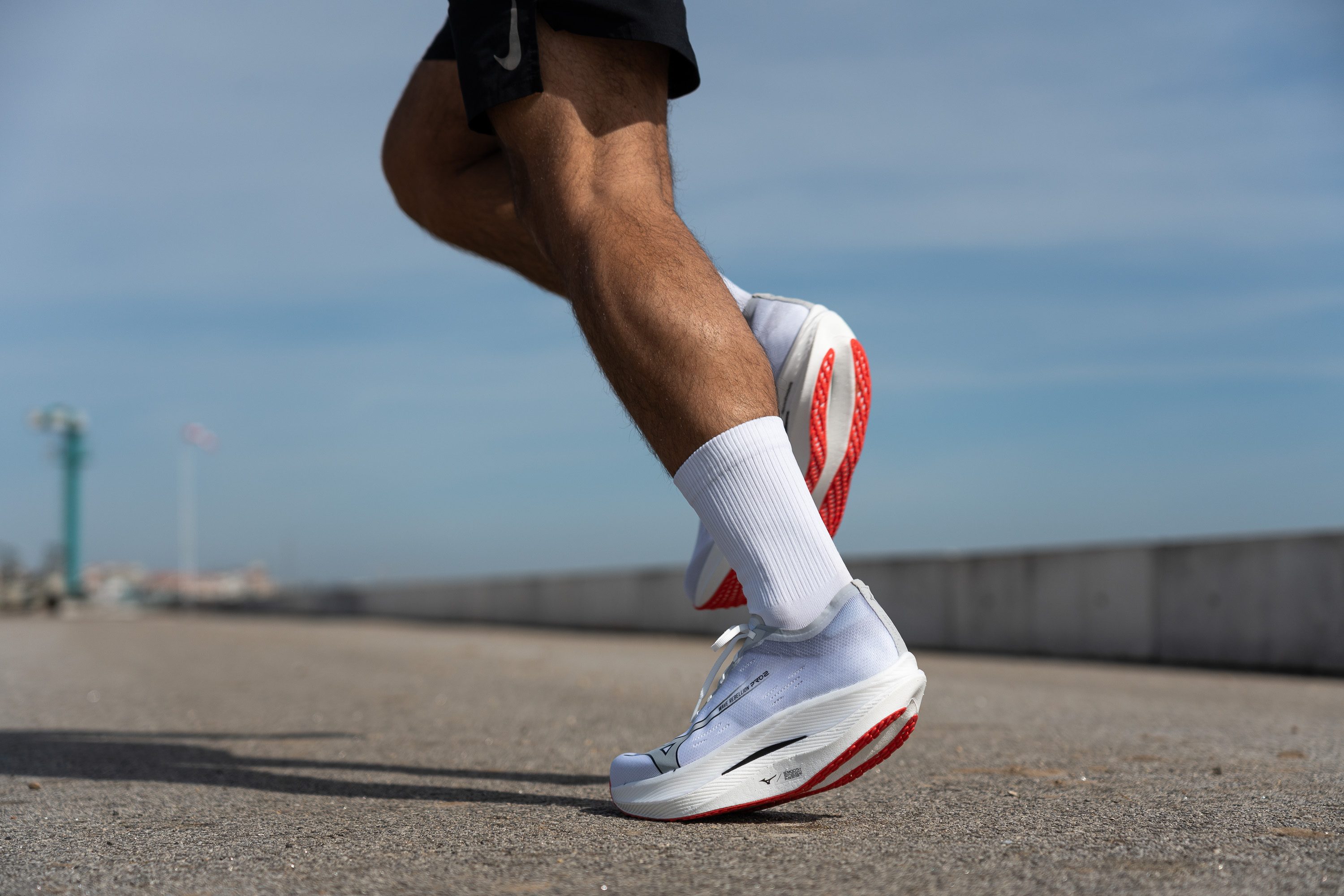
| Wave Rebellion Pro 2 | 2.1 mm |
| Average | 8.6 mm |
Midsole softness
Diving into the midsole, there's plenty to dissect here, and not all of it good. We must highlight that the shoe's dual-foam setup, featuring different compounds, is arguably its Achilles' heel.
Mizuno opted for a softer Enerzy Lite+ (PEBA) top layer paired with a denser Enerzy Lite (TPE) base, rather than employing a full-PEBA midsole like many leading super shoes.
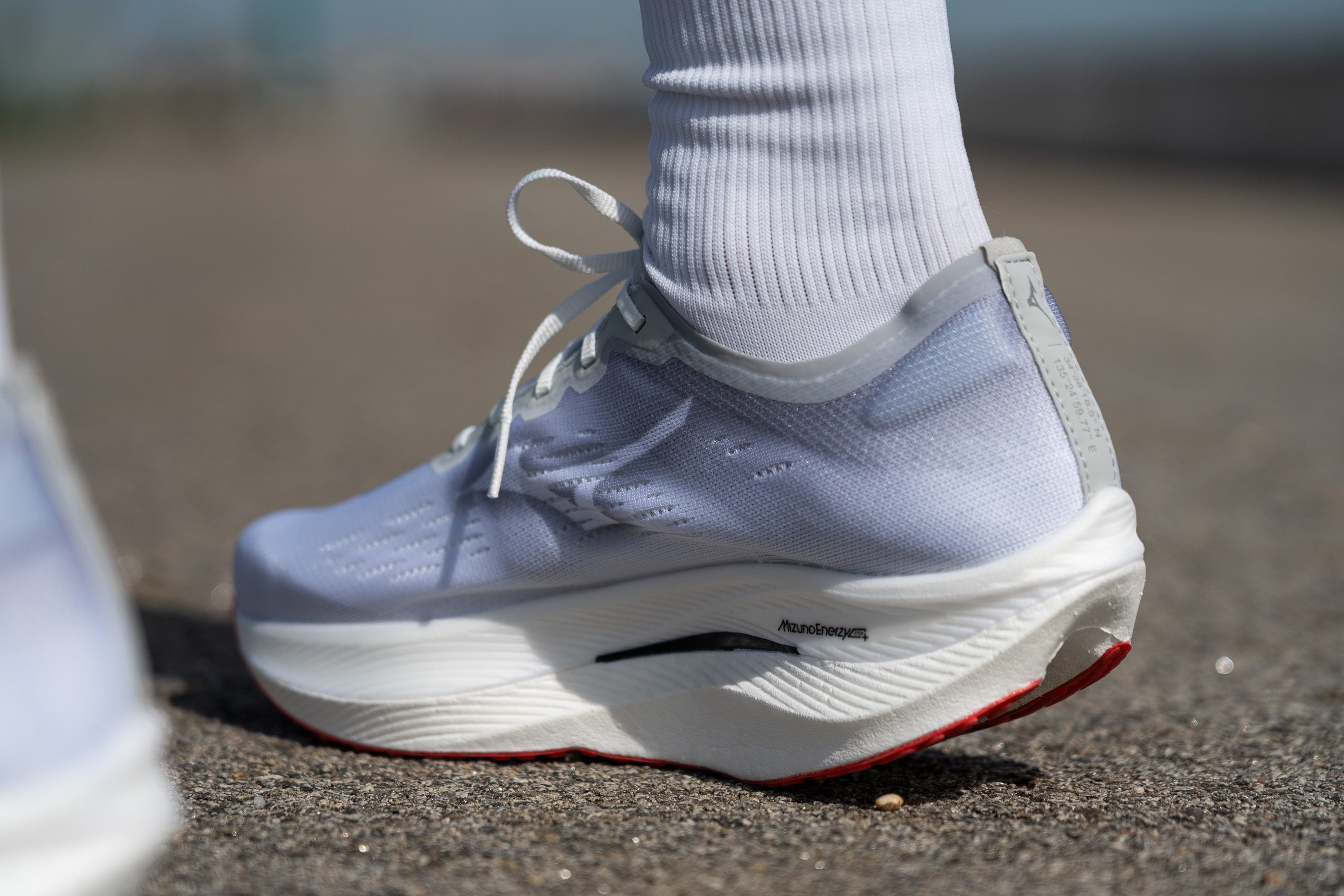
This choice, while offering stability, regrettably places the shoe a step behind the elite racers in performance metrics, as Enerzy Lite falls short in delivering the explosive energy return seen in premier superfoams—a significant letdown.
The top slab of Enerzy Lite+, measured at a plush 16.0 HA on our durometer, is undeniably comfortable and bouncy. But what about the lower layer?
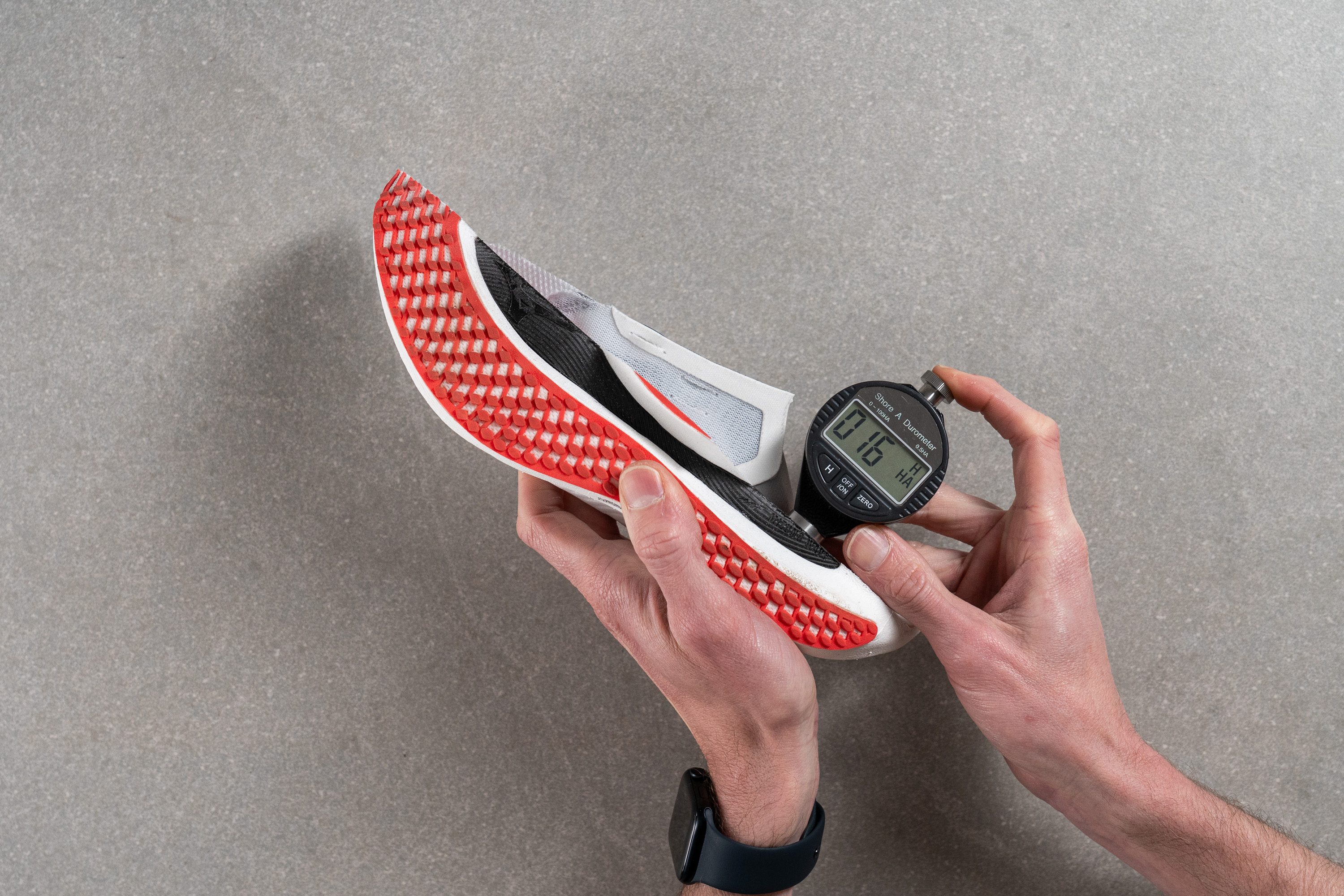
| Wave Rebellion Pro 2 | 16.0 HA |
| Average | 20.4 HA |
Secondary foam softness
The base layer of Enerzy Lite foam in this shoe, clocking in at 26.0 HA, is a firmer, TPE-based material that, while durable and offering better-than-EVA energy return, lacks the bounce of Enerzy Lite+ or other PEBA-based foams.
We firmly believe that for the WRP3, Mizuno must use a denser version of Enerzy Lite+, akin to how Nike utilises ZoomX with different densities in the Vaporfly 3. Relying on a less efficient, cheaper foam is a letdown in a shoe priced at £250.
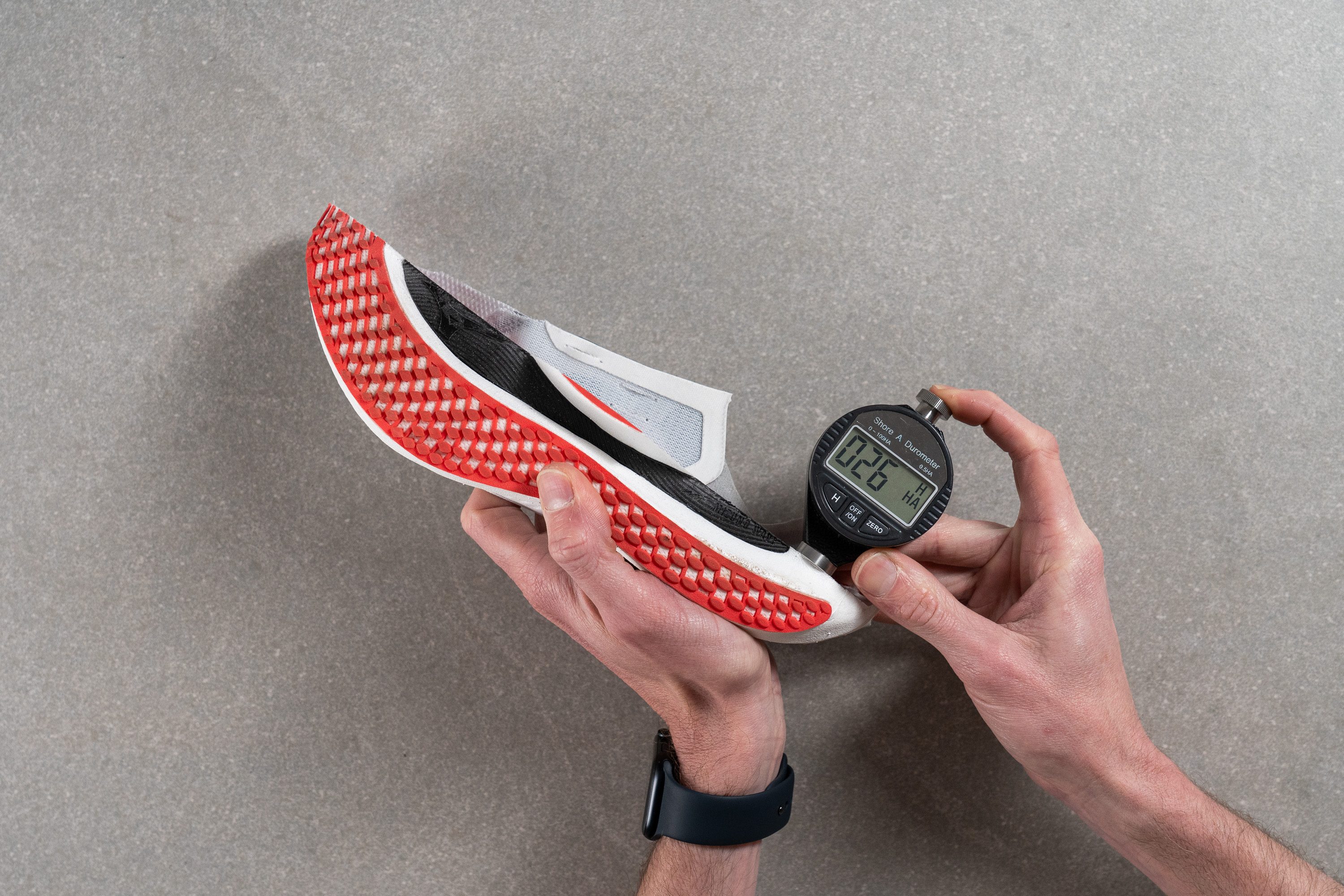
| Wave Rebellion Pro 2 | 26.0 HA |
| Average | 22.8 HA |
Rocker
A standout feature of the Wave Rebellion Pro series is undoubtedly its unique midsole geometry.
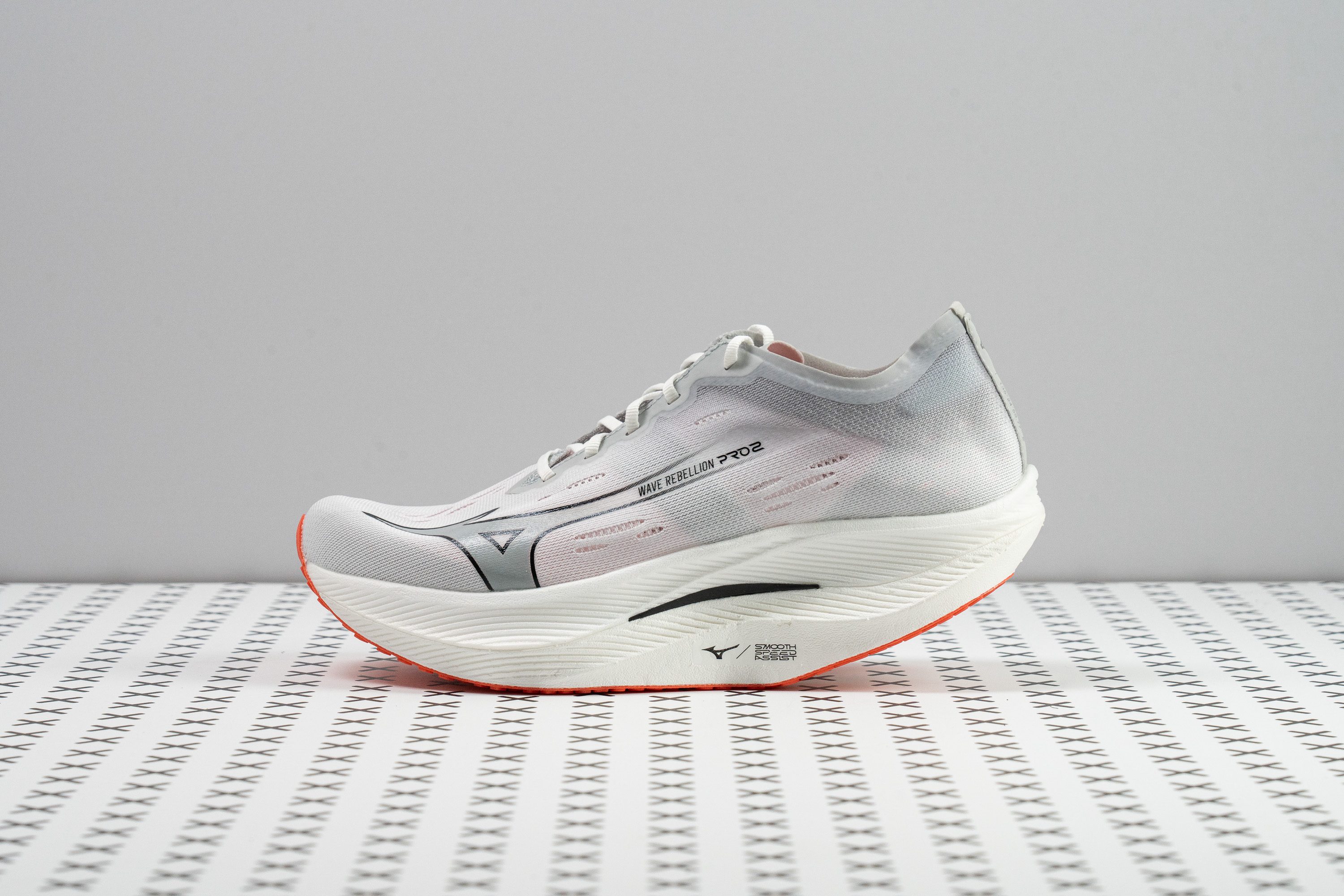
The design incorporates an exaggerated heel bevel with two objectives: to align with World Athletics' maximum stack height requirement of 40 mm at the measurement point and to enhance forward momentum—potentially even altering the footstrike of runners who alternate between midfoot and rearfoot techniques.
Additionally, there's a significant rocker in the forefoot, which, in our opinion, initiates slightly later than ideal. Thus, forefoot strikers might not fully benefit from the unconventional geometry, and heel strikers may not experience as smooth a transition as they would with other rockered shoes, such as the Hoka Cielo X1.
Plate
Mizuno continues its approach of not using a full carbon-fibre plate for this series, opting instead for a carbon-infused nylon Wave plate that's at least significantly stiffer than its predecessor—a change we'll detail shortly.
Positioned between the foam layers, the plate is distinctly designed to favour midfoot strikers, enhancing their forward propulsion. However, those who predominantly land on their forefoot or heel may not experience the full potential of this shoe due to its specific design.

Size and fit
Size
Mizuno Wave Rebellion Pro 2 fits true to size (22 votes).
Width / Fit
The moment we stepped into the Wave Rebellion Pro 2, we were struck by the exceptionally roomy upper for being a competition shoe.

Our tests quantitatively echoed this outstanding level of comfort, with measurements revealing a notable maximum width of 98.1 mm.

This test follows an older methodology, which is why you don't see recently tested shoes in the chart. Results from different methodologies can not be compared.
| Wave Rebellion Pro 2 | 98.1 mm |
| Average | 98.5 mm |
Toebox width
The spaciousness in the big toe area mirrors that of a daily trainer, offering ample room for toe splay at 77.6 mm.
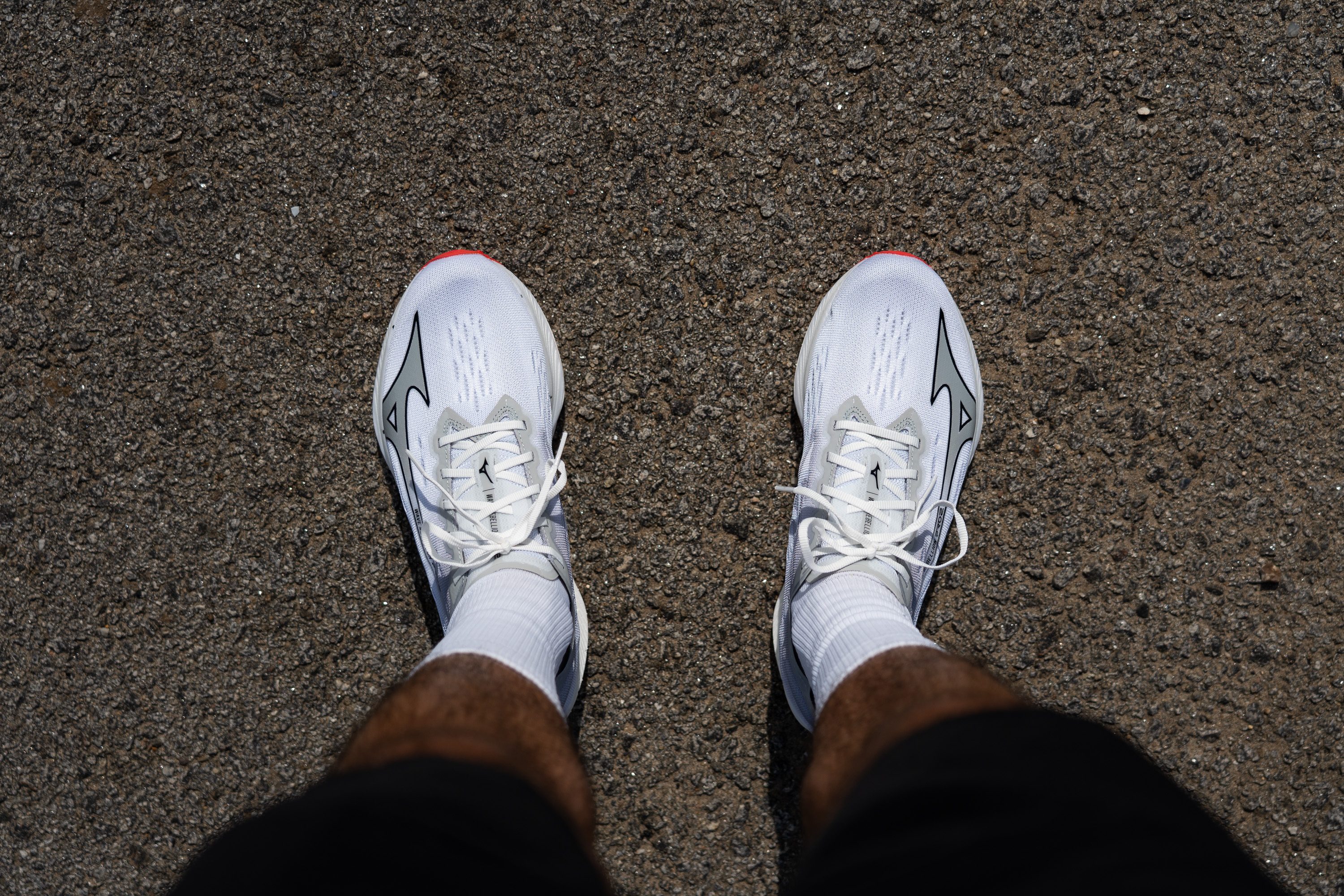
This feature positions the shoe as an excellent choice for those who find traditional racing uppers too restrictive.

This test follows an older methodology, which is why you don't see recently tested shoes in the chart. Results from different methodologies can not be compared.
| Wave Rebellion Pro 2 | 77.6 mm |
| Average | 78.4 mm |
Traction / Grip
Traction test
Based on our lab test, traction proved dependable. The 0.46 score indicates solid grip across all types of dry surfaces and enough hold for rainy days—though not standout like in the ASICS Metaspeed Sky Paris. Still, no need to swap shoes on race day regardless of the forecast.
| Wave Rebellion Pro 2 | 0.46 |
| Average | 0.48 |
Outsole design
The outsole of the Mizuno Wave Rebellion Pro 2 features a full-length G3 rubber compound. The red rubber is applied across the entire length of the shoe, offering near-total coverage with consistent thickness and a lightweight feel. That's quite rare for a super shoe!
A central cutout runs through the length of the outsole, exposing the black carbon plate for weight savings.

Flexibility / Stiffness
We committed to a closer examination of the carbon-infused Wave plate, and now it's time to share our findings. To gauge its stiffness, we conducted our 30-degree bend test, registering a force of 21.7N—comparable to many carbon-fibre plates used in other top racing shoes.
This begs the question: why not opt for a full carbon-fibre plate, as demonstrated by all leading super shoes? It seems we may have to await the next iteration for this.
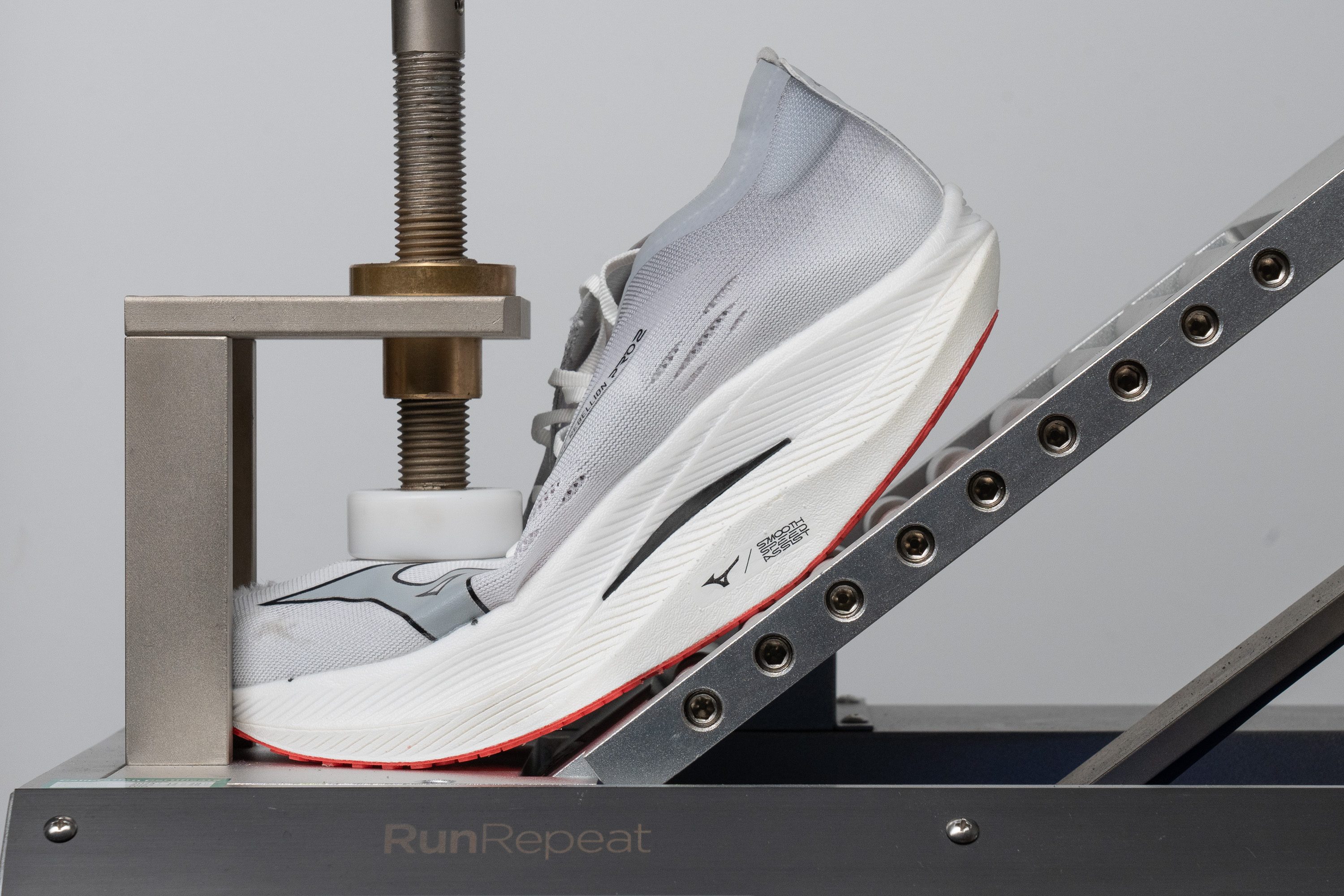
| Wave Rebellion Pro 2 | 21.7N |
| Average | 15.3N |
Stiffness in cold (%)
We were curious about how stiffness might vary in colder conditions, given that many marathons take place in cooler climates. Following a 20-minute stint in the freezer, we repeated our test and observed a significant 25.5% increase in stiffness—a clearly discernible difference.
| Wave Rebellion Pro 2 | 26% |
| Average | 33% |
Weight
Upon unboxing and handling the Mizuno Wave Rebellion 2 Pro, it initially seemed akin to its predecessor.
However, after placing it on the scale, we were pleasantly surprised to find it slightly lighter, tipping the scales at just 7.4 oz or 209g. Kudos to Mizuno for this one!
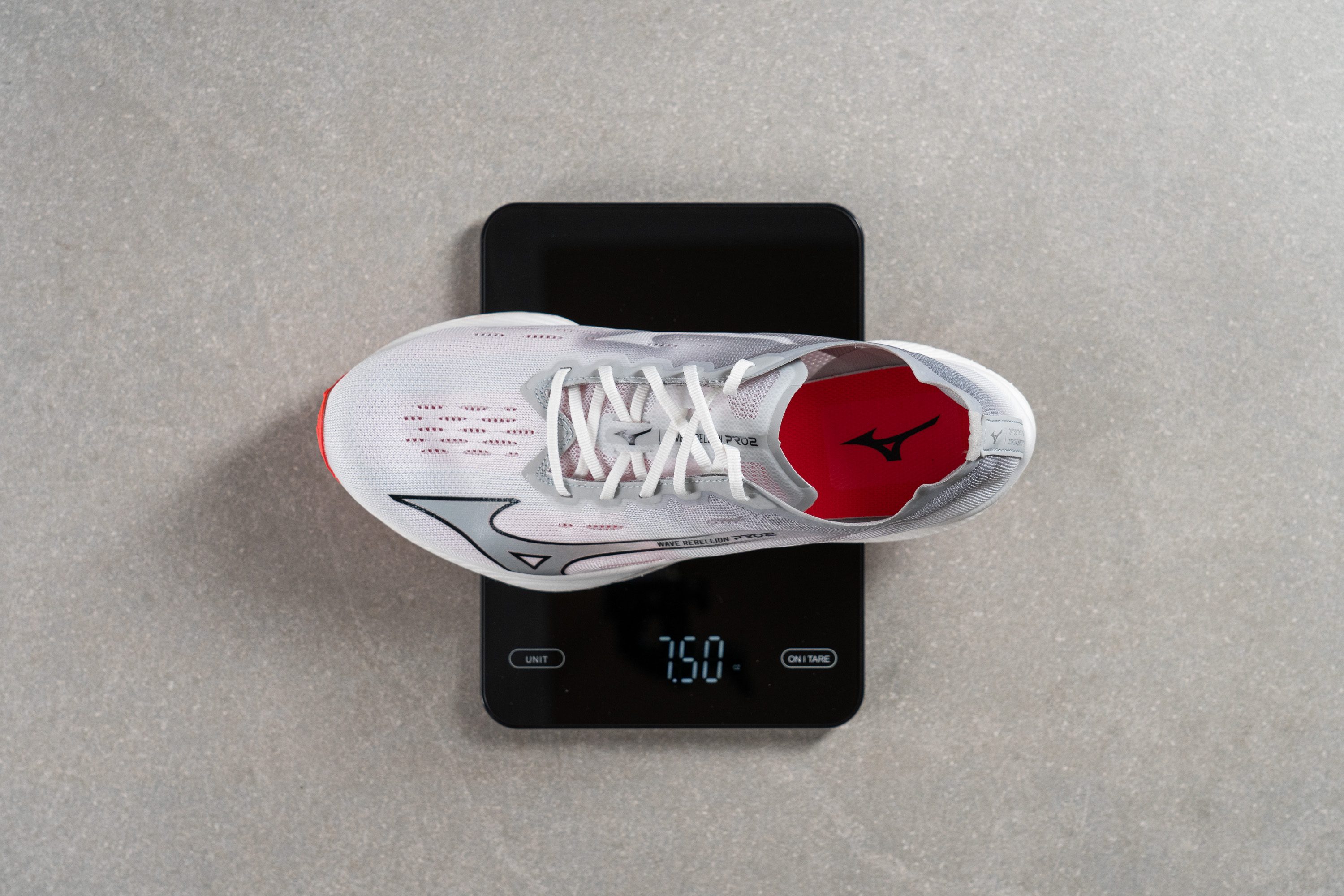
| Wave Rebellion Pro 2 | 7.4 oz (209g) |
| Average | 9.3 oz (264g) |
Breathability
At a £250 price point, we expected the Wave Rebellion Pro 2 to deliver on breathability, especially for race day.
Eager to test its unique design, we started with the smoke test in our lab, scoring an impressive 4/5. We were pleased to find that airflow wasn't limited to the toebox—both the tongue and medial zone also excelled in ventilation, and there's a bit too in the heel!
Our next step involved a powerful light test, revealing the upper's thinness, structured solely around the heel, while the midfoot and forefoot appeared almost paper-thin. However, Mizuno ingeniously integrated a robust reinforcement in the medial area for enhanced stability, clearly visible in our video.
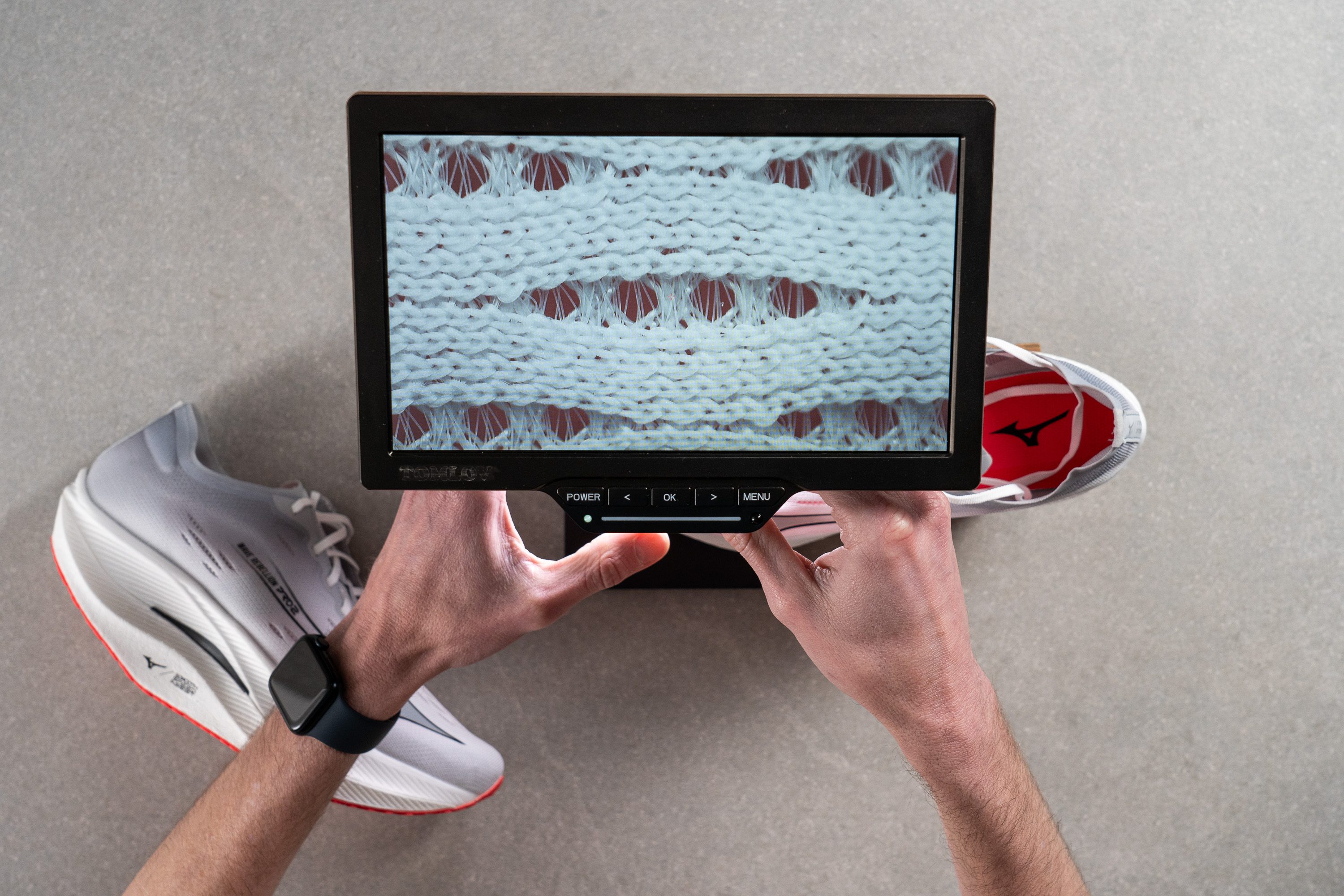
Delving deeper with a microscope, we aimed to closely examine the engineered mesh and ventilation holes.
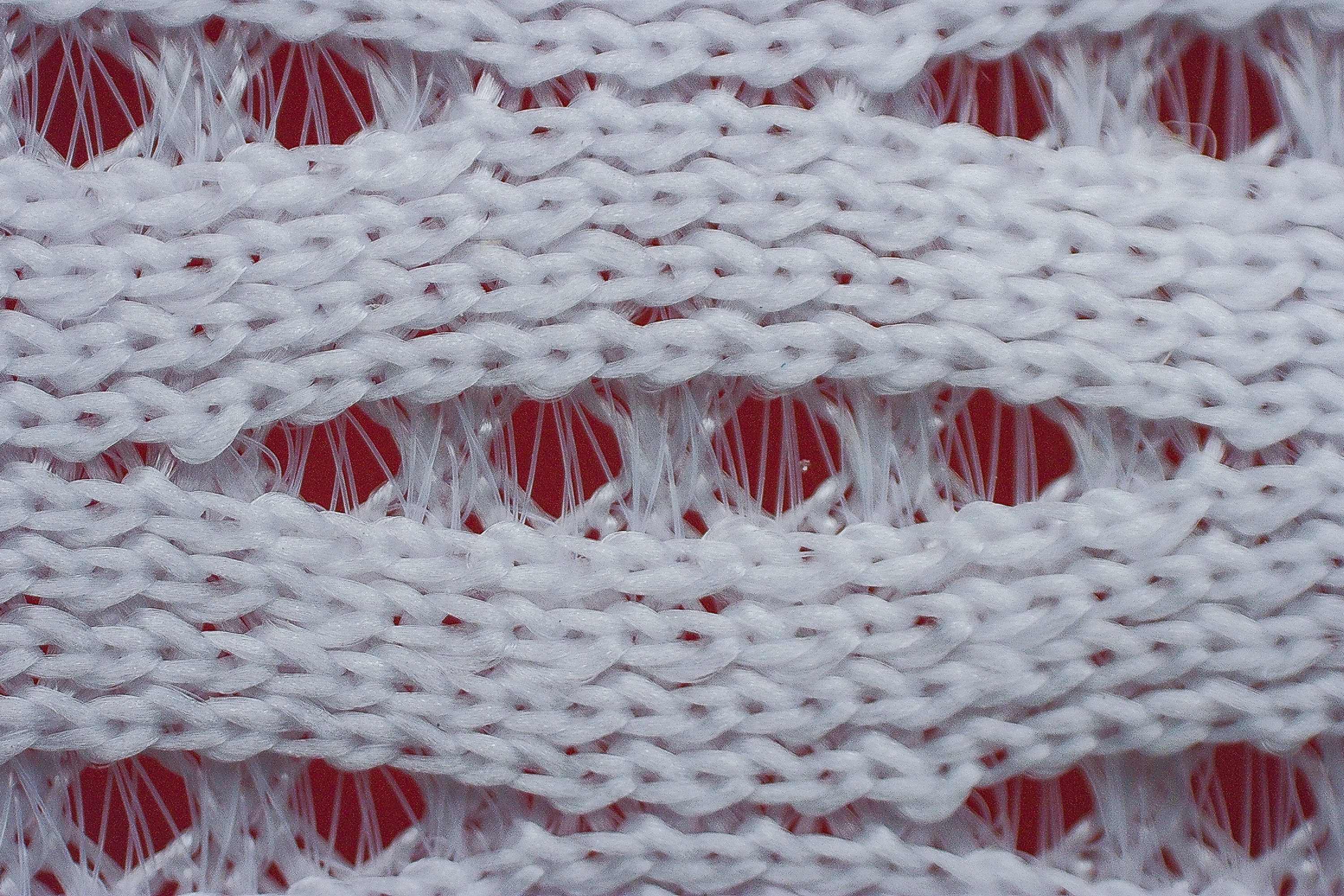
The strategic placement of these holes throughout the upper, rather than uniformly, significantly boosted overall ventilation.
Wrapping up with a manual inspection of the sliced upper, we noted the shoe's pursuit of ultimate lightness, evident in the absence of padding. Yet, the well-thought-out ventilation areas, especially beyond the toebox, stood out as a smart design choice for marathoners.
| Wave Rebellion Pro 2 | 4 |
| Average | 3.7 |
Stability
Lateral stability test
Boasting a towering stack height in the midfoot coupled with its narrow build, achieving stability in this shoe feels like an elusive dream.
Through our extensive testing—spanning hundreds of shoes—we can assert that this model ranks among the least stable we've encountered.
On a brighter note, there's some positive news. Firstly, it's significantly more stable than its predecessor. Additionally, for those who primarily run in straight lines and possess a neutral gait, the shoe offers a fantastic feel! But leave it at home for your next twisty 5K or 10K, please.
Torsional rigidity
In our hands-on evaluation, we encountered substantial torsional rigidity, unanimously earning a 5/5 in our lab tests. This was precisely in line with our expectations and is crucial for providing a bit of stability to this skyscraper-high shoe.
| Wave Rebellion Pro 2 | 5 |
| Average | 3.5 |
Heel counter stiffness
The heel counter is almost negligible, offering barely any structure and reinforcing its suitability solely for neutral runners at 1/5.
Anyone requiring even slight heel support should steer clear of this super shoe and opt for the ASICS Superblast instead.
| Wave Rebellion Pro 2 | 1 |
| Average | 2.9 |
Midsole width - forefoot
Exploring the shoe's dimensions reveals a pretty standard forefoot width of 113.3 mm. The intrigue lies in how Mizuno managed to maintain a light weight for such a tall shoe with a decent width. The secret is in the midfoot's design—a prominent central groove extending from the heel to the forefoot.
This feature ingeniously allows for a broader shoe. It's a clever strategy that's already a trend in super shoes, offering the dual benefits of enhanced stability and reduced weight without compromising on overall foam volume.
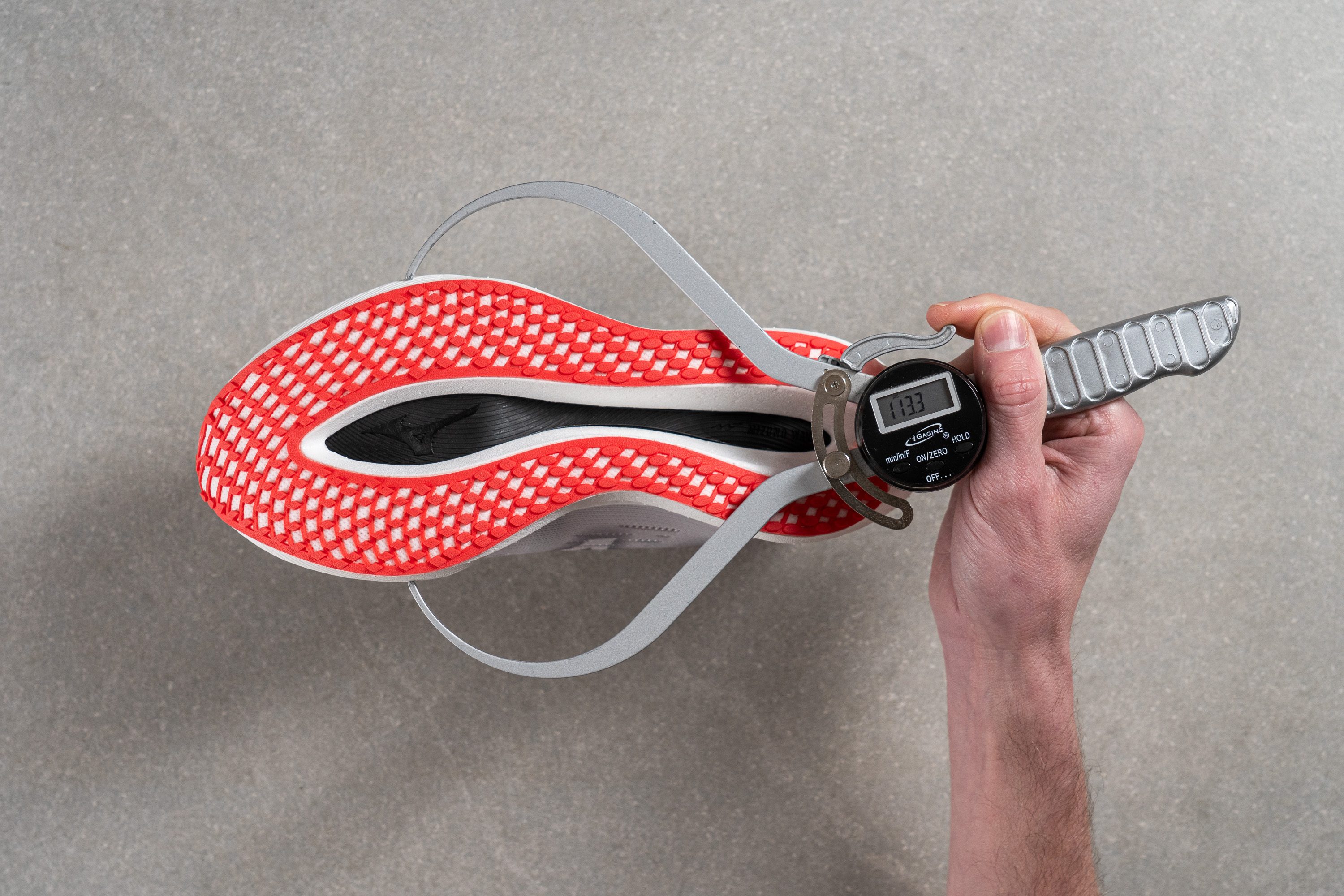
| Wave Rebellion Pro 2 | 113.3 mm |
| Average | 114.4 mm |
Midsole width - heel
We've previously determined this shoe might not be the best fit for heel strikers, given the superior options available. This is further confirmed by the heel's measurement of only 82.0 mm, solidifying the shoe's design as more suited for midfoot landing.
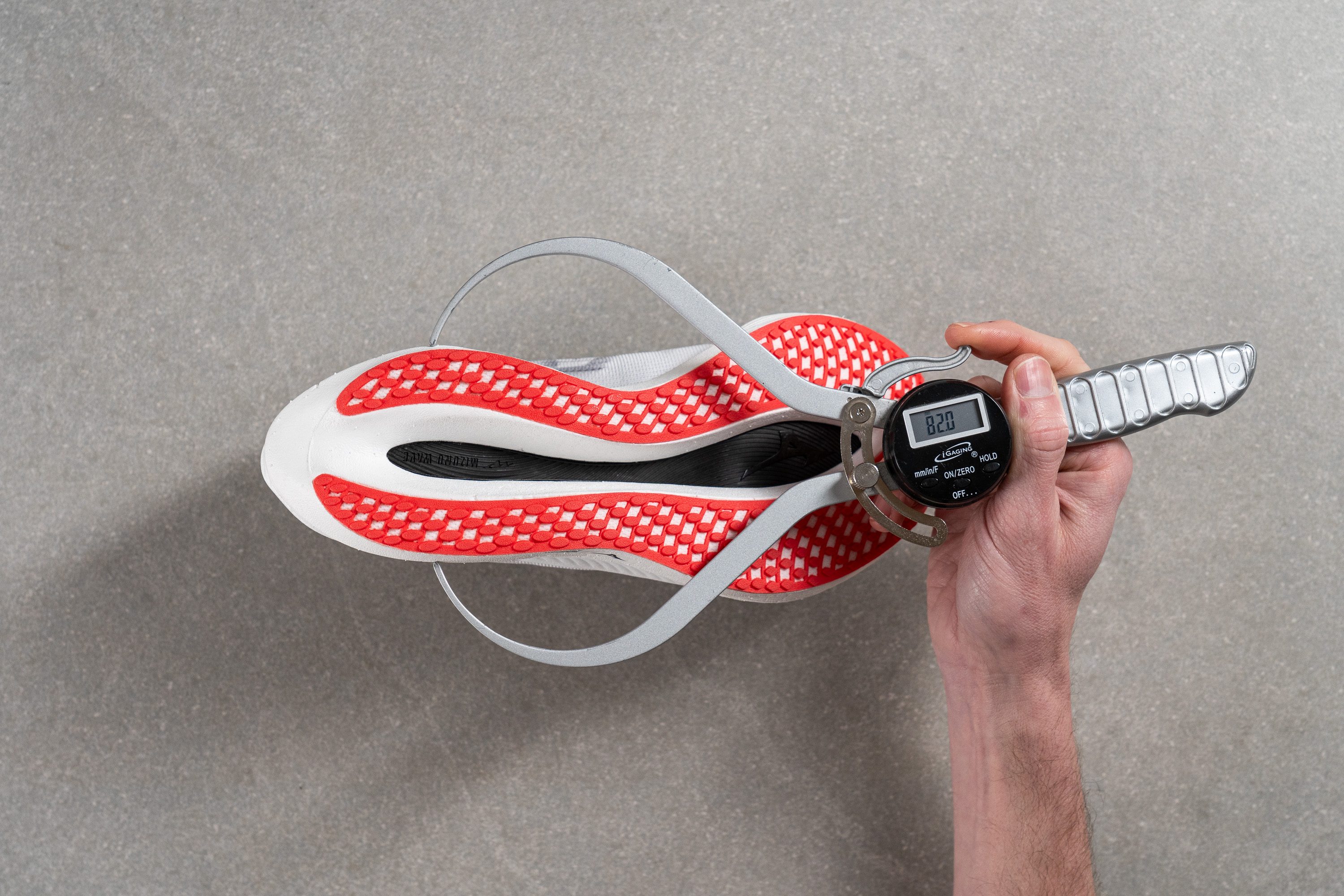
| Wave Rebellion Pro 2 | 82.0 mm |
| Average | 90.7 mm |
Durability
Toebox durability
Mizuno's use of such thin engineered mesh set our expectations incredibly low even before we initiated our first durability test with the Dremel. But we held off judgement until seeing the results.
Regrettably, the outcome was as disappointing as we feared. The test left a complete hole in the upper, compelling us to assign the Wave Rebellion Pro a dismal 1/5 rating.

| Wave Rebellion Pro 2 | 1 |
| Average | 2.6 |
Heel padding durability
The heel padding is notably sparse, yet Mizuno has sewed a protective strip, intended to significantly enhance this area's durability.
Following our second Dremel test, conducted under identical conditions, we were pleased with a 4/5 outcome. Nonetheless, we're eager for the next iteration—hoping for a sleeker application of this protective strap, perhaps through adhesion, and coupled with additional padding for enhanced comfort.
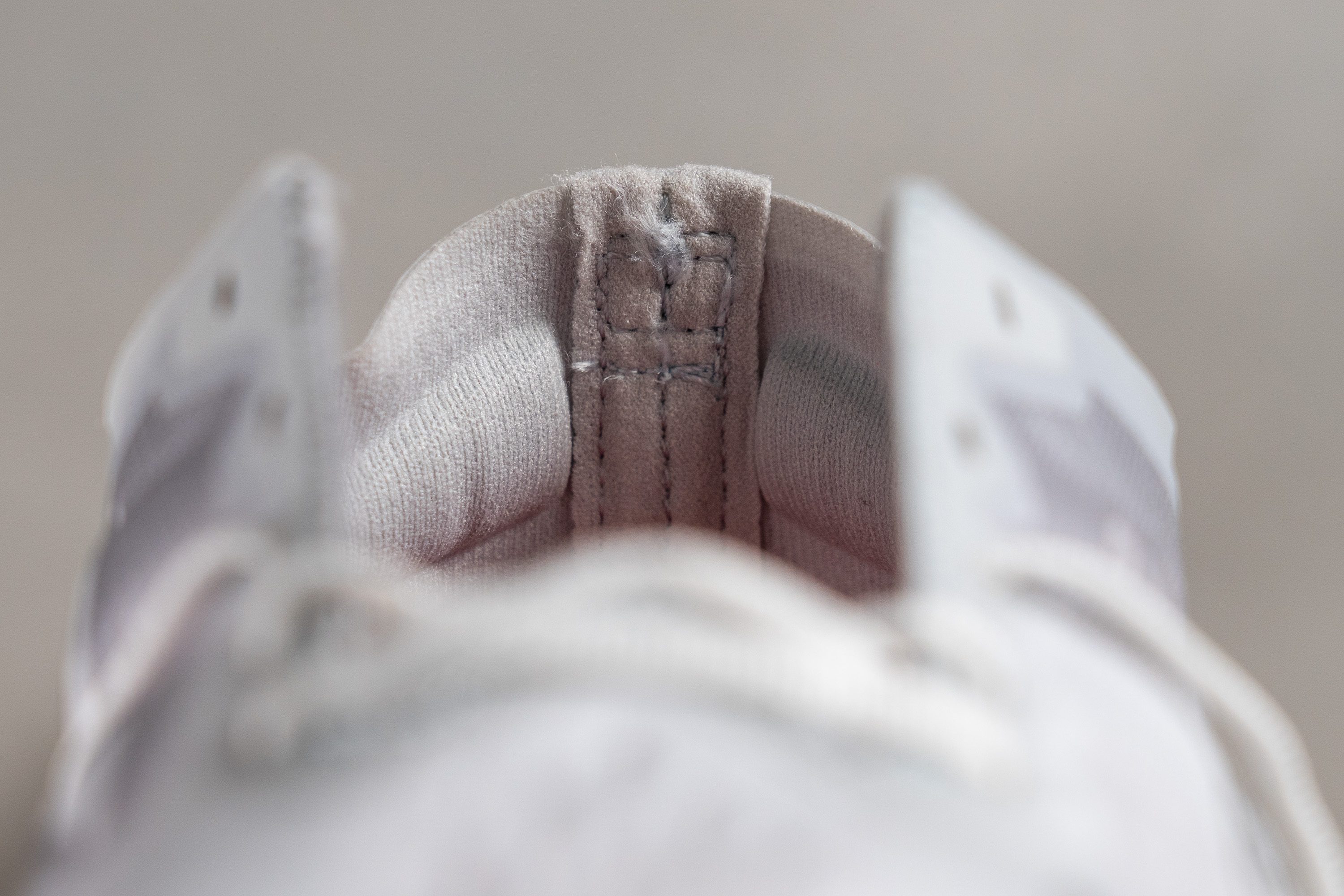
| Wave Rebellion Pro 2 | 4 |
| Average | 3.4 |
Outsole hardness
Following mixed outcomes from the initial durability tests, our attention shifted to the outsole. While durability isn't typically the main focus for racing shoes—where grip takes precedence—many runners still value a competition shoe that endures beyond a hundred miles.

We started with the durometer, registering a 77.8 HC hardness for the G3 Rubber outsole. And we must emphasise—the traction is actually mind-blowing.

| Wave Rebellion Pro 2 | 77.8 HC |
| Average | 79.2 HC |
Outsole durability
To assess the durability of the ultra-grippy outsole on the Wave Rebellion Pro 2, we fired up the Dremel for a final test. What did we discover?
Our expectations were set for a less-than-ideal result due to its high grip, but the reality was even more disappointing. The Dremel completely obliterated the mini-lug we tested (1.9 mm). We advise runners against choosing this shoe for highly abrasive terrains, as it's evidently designed with just road running in mind.
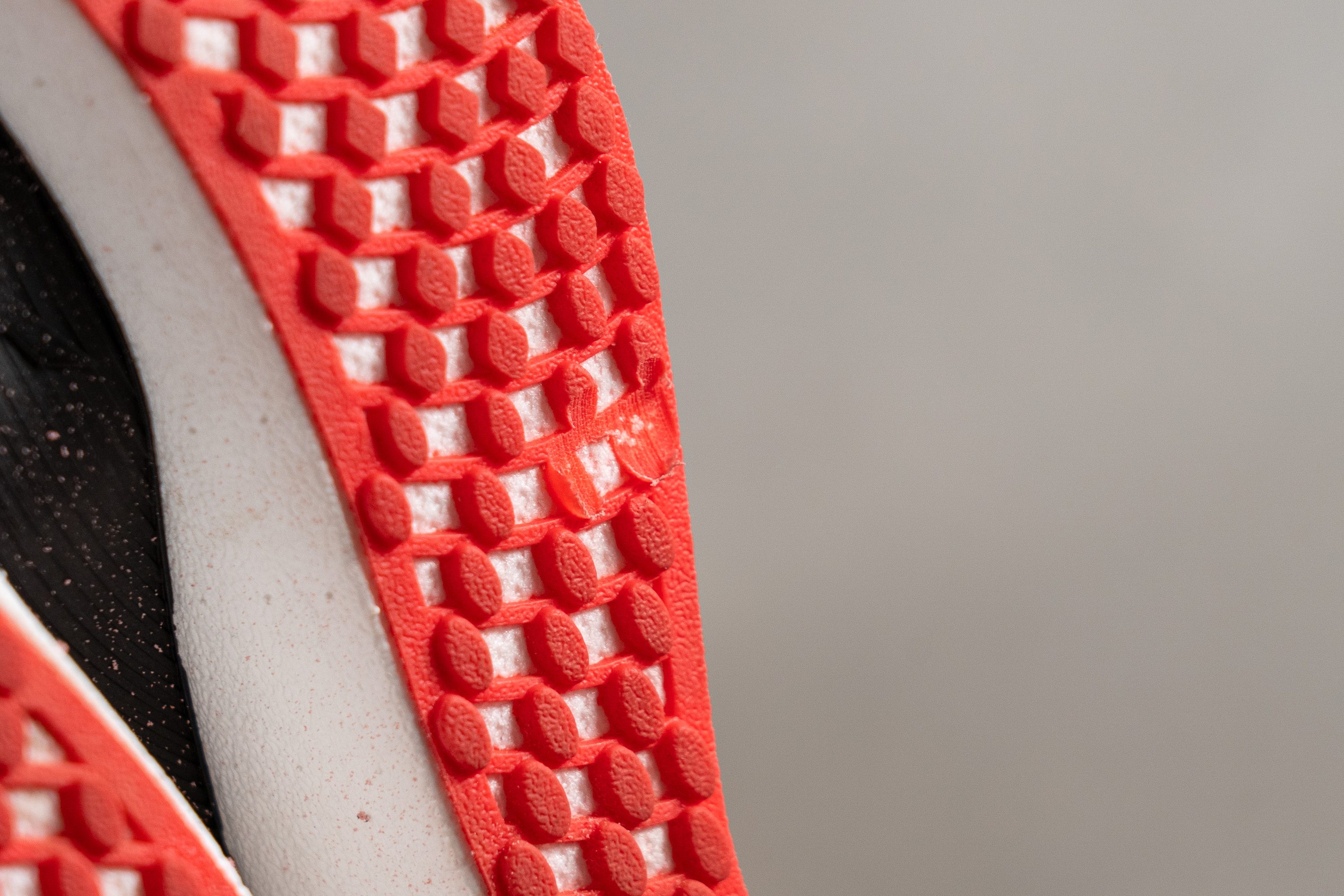
| Wave Rebellion Pro 2 | 1.9 mm |
| Average | 1.1 mm |
Outsole thickness
The low outsole's thickness at just 2.1 mm is typical for a high-performance super shoe.

While a thicker layer of rubber could enhance durability, the primary goal here is speed, forcing a lighter build. An added advantage of the slim outsole we discovered is a more responsive ride, providing a less muted connection with the ground.

| Wave Rebellion Pro 2 | 2.1 mm |
| Average | 3.2 mm |
Misc
Insole thickness
The insole of this shoe, at a mere 3.6 mm, is slimmer than what we typically encounter in training footwear. For comparison, its training sibling, the Wave Rebellion, sports a 4.1 mm sockliner.
This approach, we've noted, is a common tactic among brands aiming to maintain the shoe's stack height within World Athletics' legal limits while still maximising the volume of midsole foam for optimal performance.
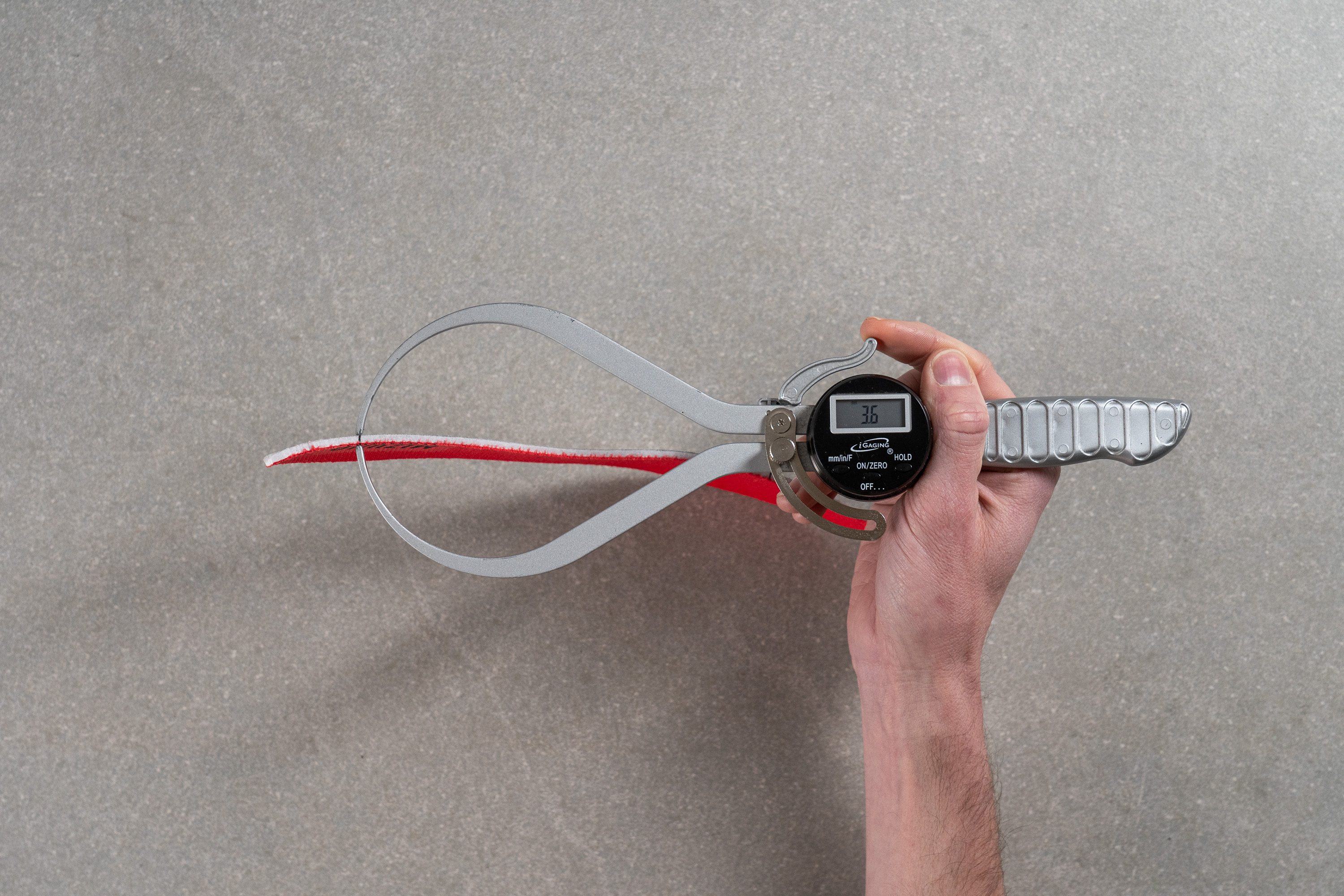
| Wave Rebellion Pro 2 | 3.6 mm |
| Average | 4.5 mm |
Removable insole
Differing from many super shoes, Mizuno has designed the insole without being fixed to the last, enabling the easy swap for custom orthotics or alternative third-party insoles.
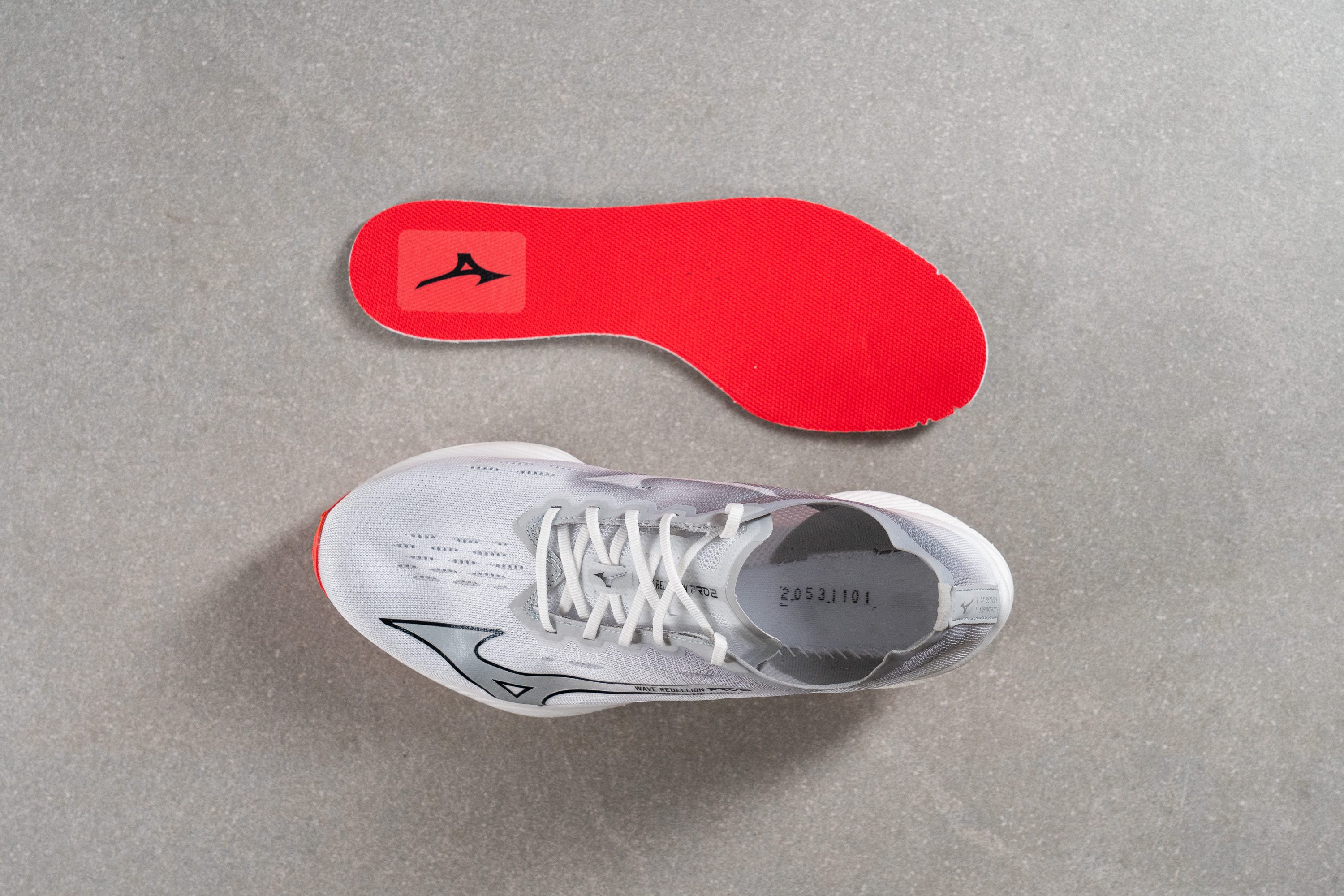
| Wave Rebellion Pro 2 | Yes |
Midsole softness in cold (%)
After chilling the shoe in the freezer for 20 minutes, we tested the primary Enerzy Lite+ foam to gauge its performance in colder temperatures.
The foam's resilience was impressive, showing only a minimal 7.1% change, mirroring the performance of top PEBA-based foams. Great!
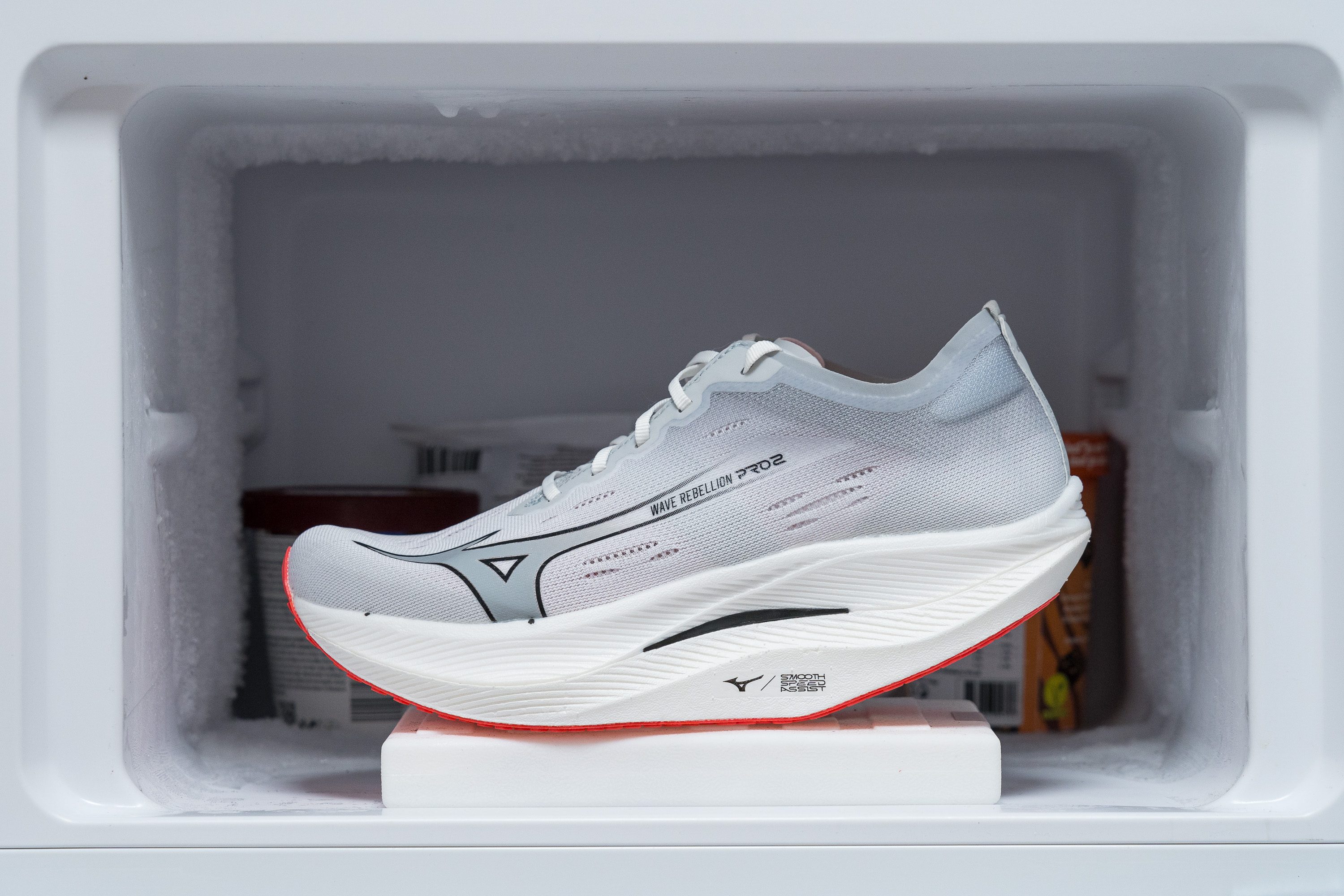
| Wave Rebellion Pro 2 | 7% |
| Average | 24% |
Reflective elements
This feature also stands out as a delightful exception among super shoes—reflective elements!
While nighttime races might be rare, the potential for an early morning tempo run means enhanced safety with this thoughtful addition.
| Wave Rebellion Pro 2 | Yes |
Tongue padding
The tongue features virtually no padding, with our measurements revealing a mere 1.3-mm thickness.
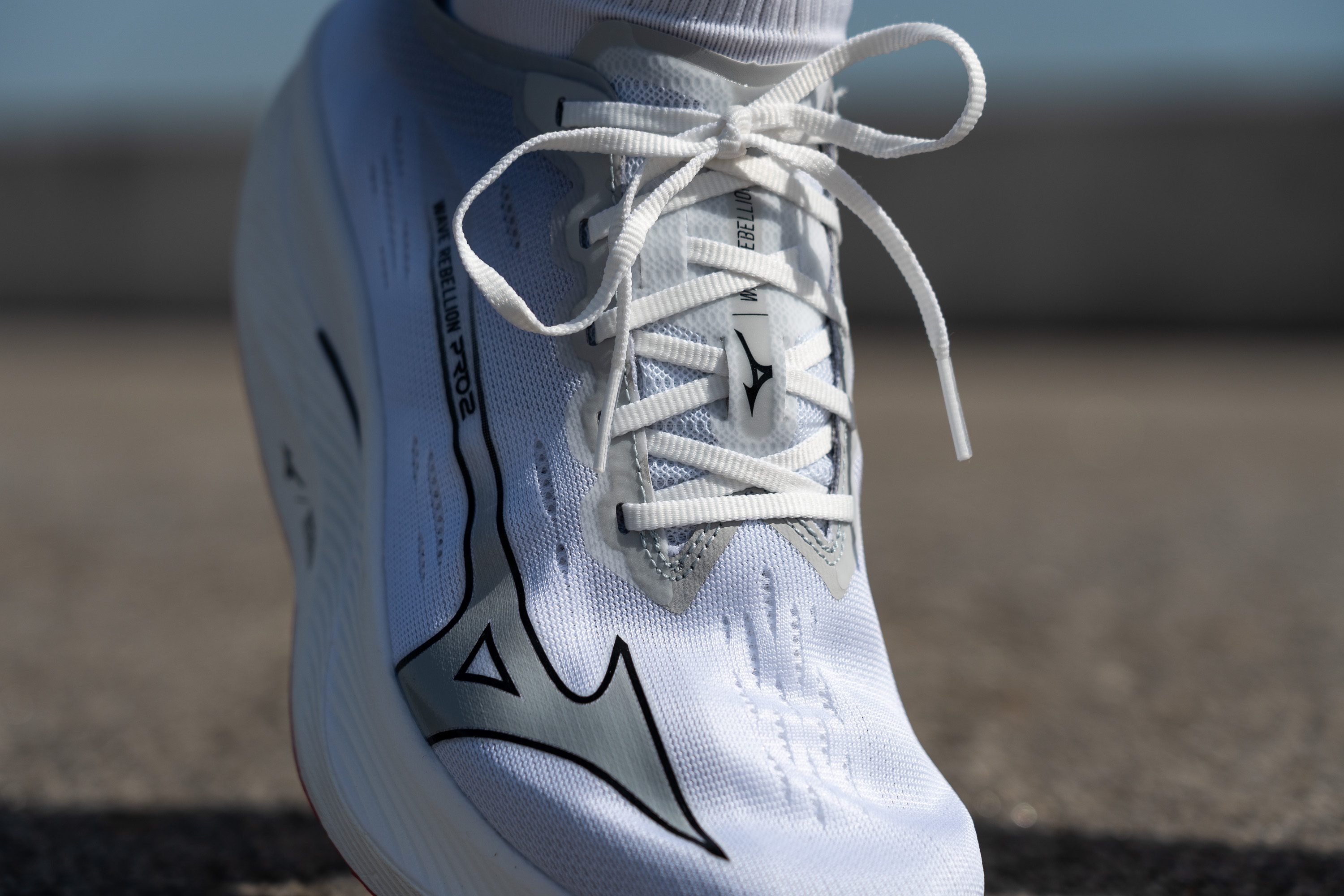
Yet, this aligns perfectly with our desire for minimal weight and maximum performance!
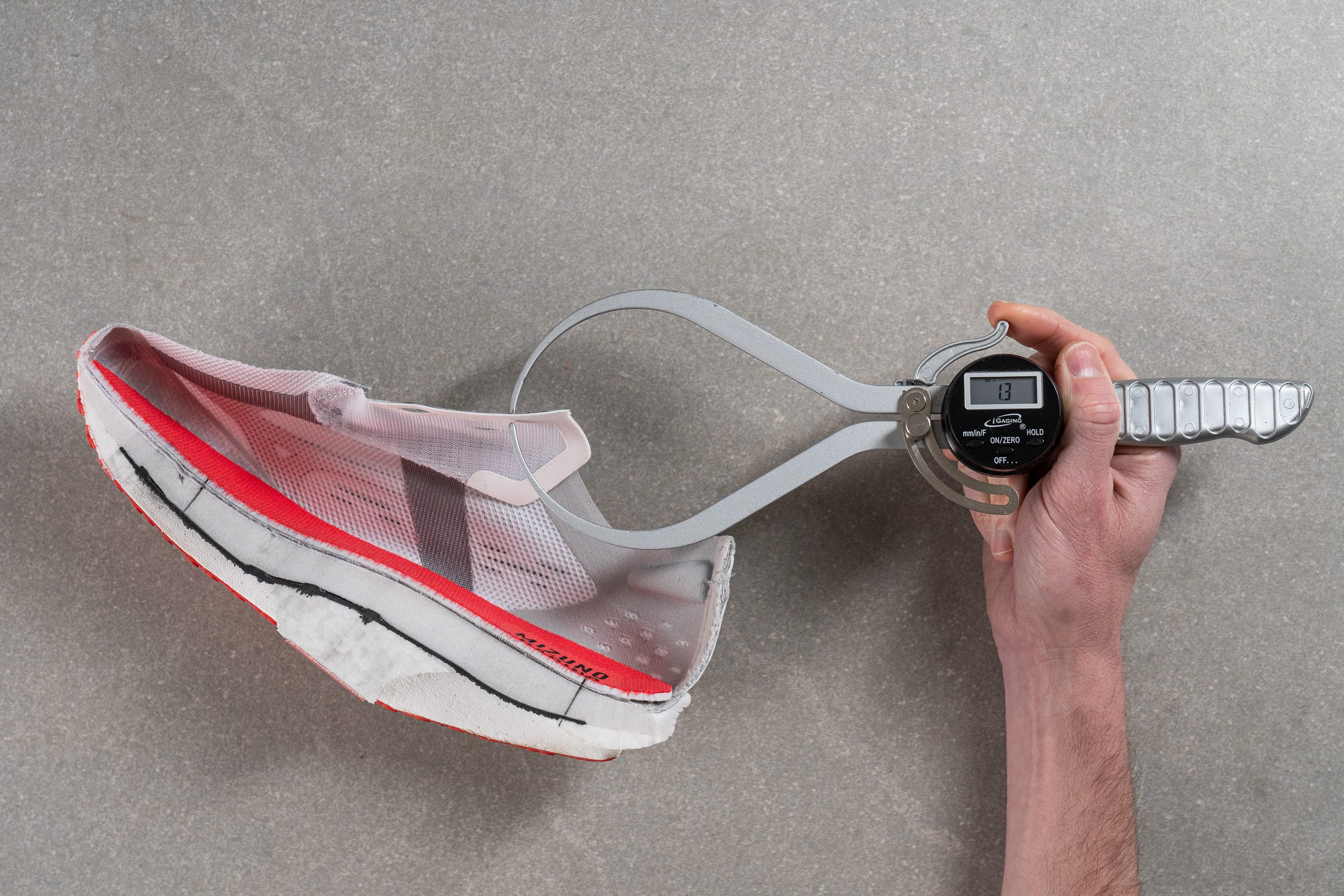
| Wave Rebellion Pro 2 | 1.3 mm |
| Average | 5.8 mm |
Tongue: gusset type
The absence of a gusseted tongue, particularly in a £250 shoe, strikes us as a significant oversight, more so in this model given that its upper lacks the ultra-snug fit characteristic of other super shoes, which prevents the tongue from shifting side to side.

| Wave Rebellion Pro 2 | None |
Heel tab
Given that the upper adopts a classic engineered mesh design rather than a bootie or sock-like structure, there's no necessity for a heel tab, allowing Mizuno to shave off some weight.
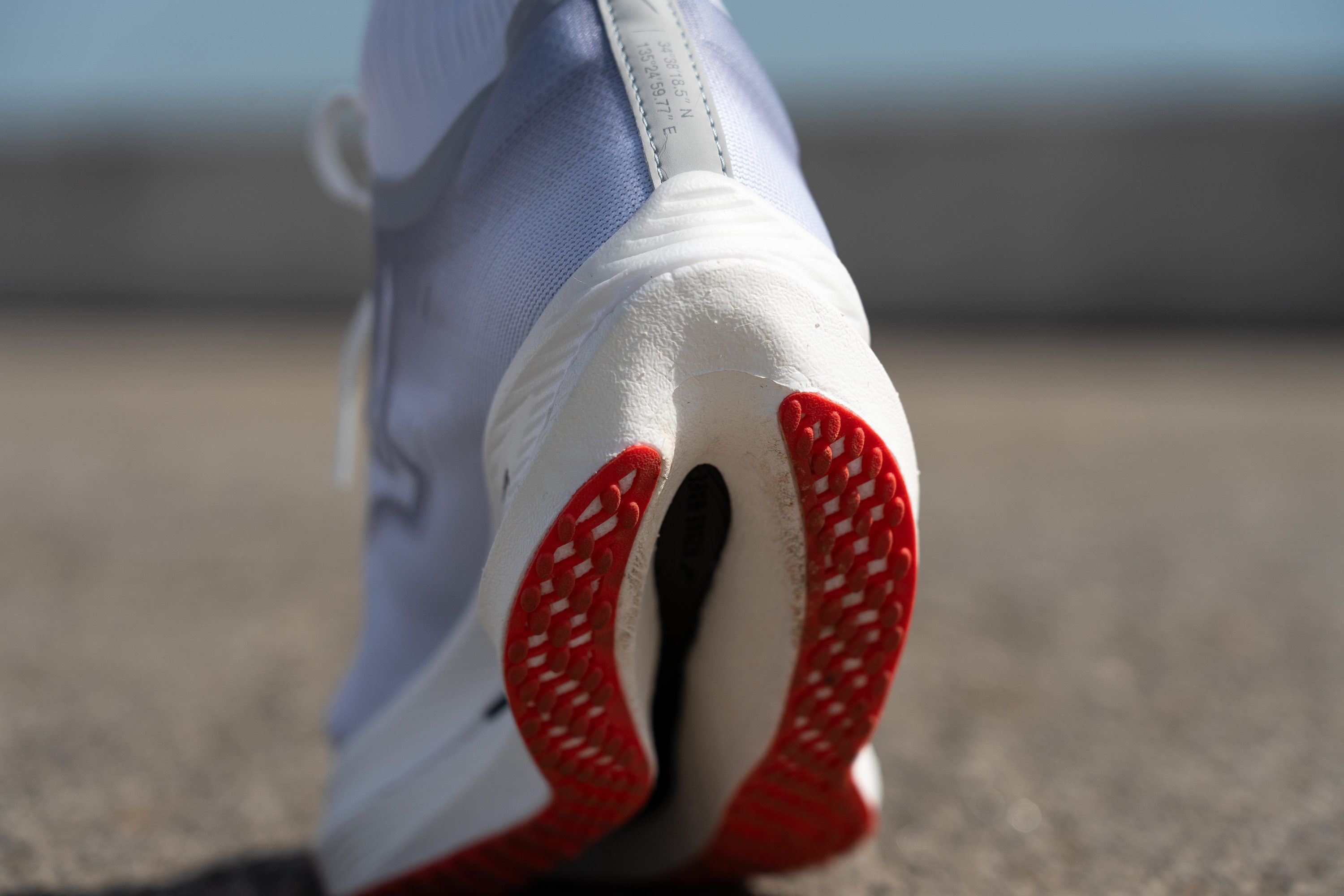
On the heel's exterior, there's an intriguing detail—the geographical coordinates marking the location of MIZUNO ENGINE, the brand's hub for research and innovation in Osaka, Japan.
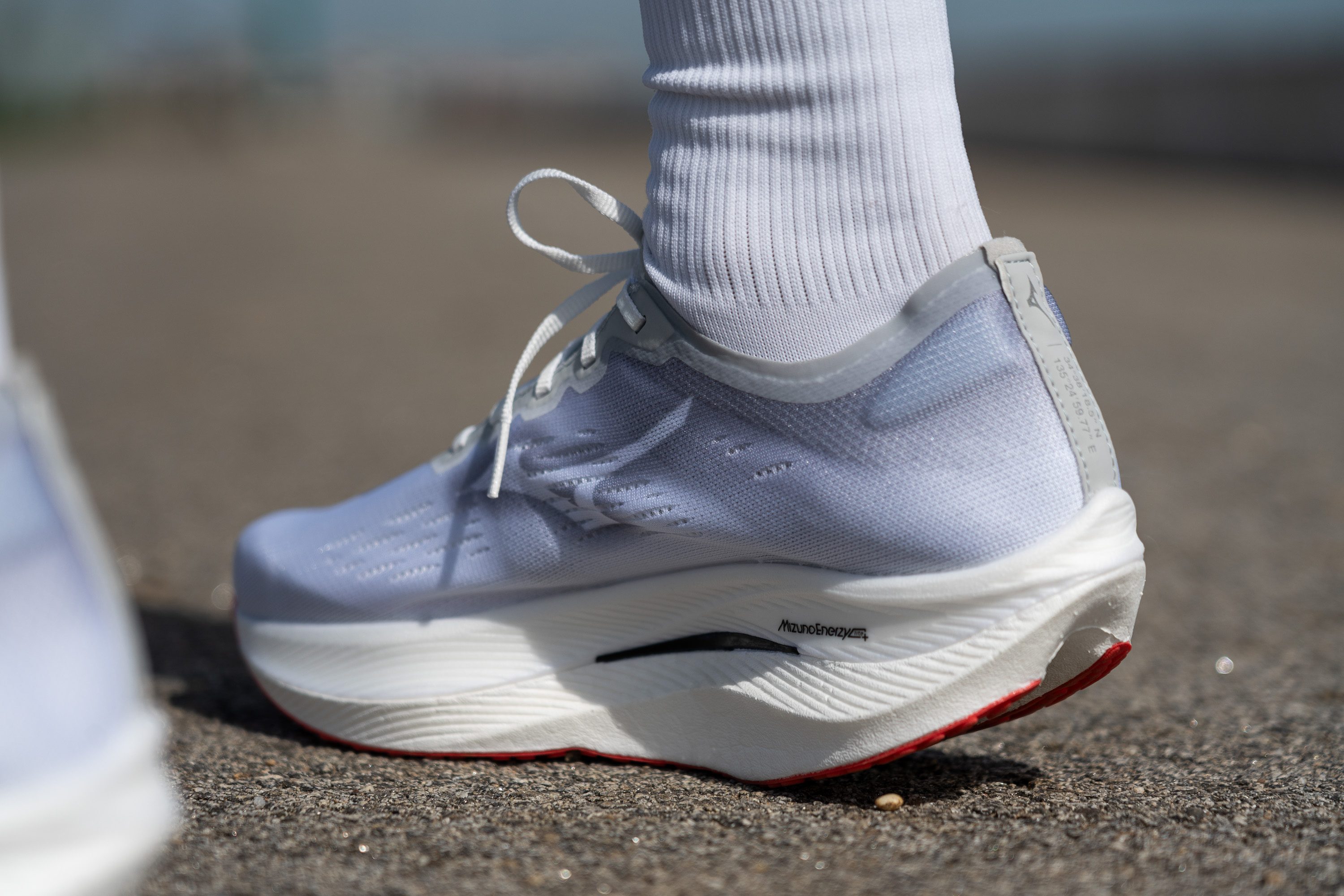
| Wave Rebellion Pro 2 | None |

